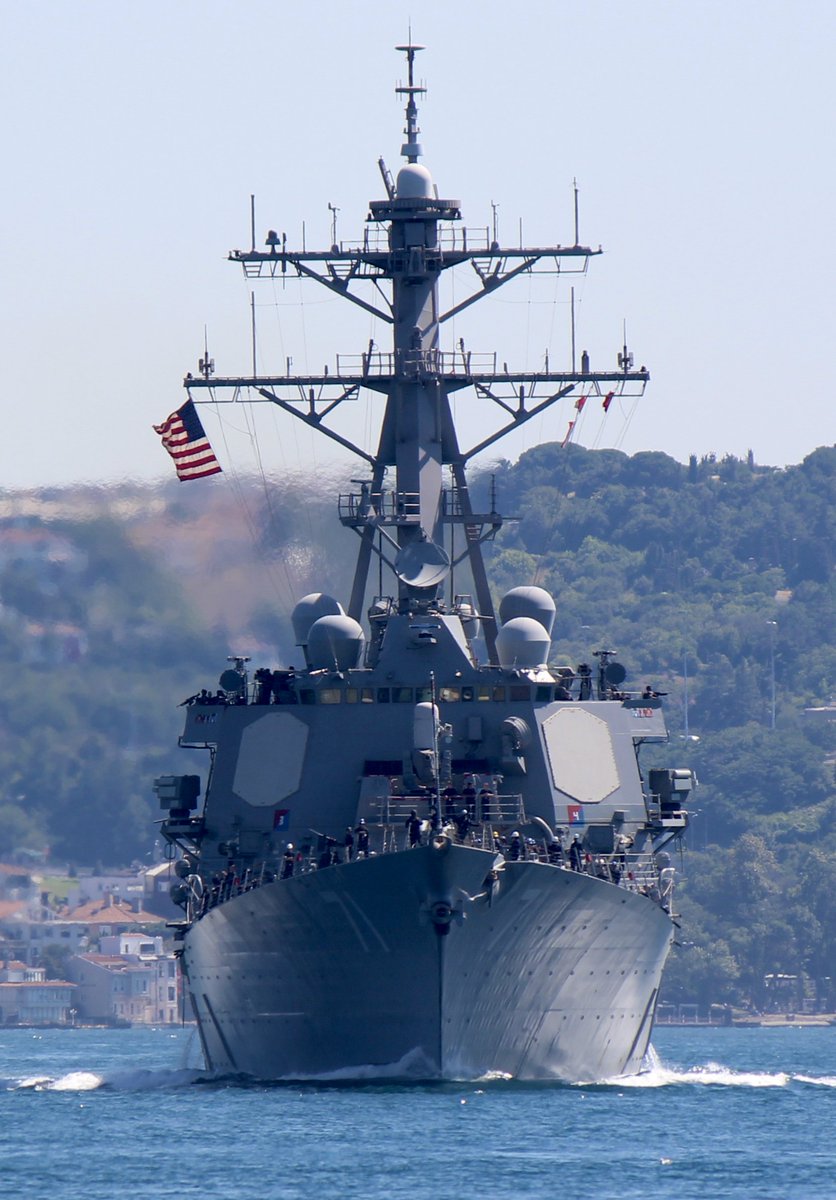
Arleigh Burke-class guided missile destroyer USS Ross DDG71 transits Bosphorus and enters the Black Sea #SeaBreeze2016: image via Yörük Isik @YorukIsik, 7 April 2017
Ansage aus Washington an Nordkoreas Herrscher Kim Jong Un:
Der atomgetriebene Flugzeugträger "USS Carl Vinson" und seine
Begleitschiffe nehmen Kurs auf die koreanische Halbinsel.: photo by AFP via Spiegel Online, 9 April 2017
Der Flugzeugträger ist nach dem US-Demokraten Carl Vinson
(1883-1981) benannt, der sich in seiner Amtszeit vor allem für den
Ausbau der Navy einsetzte.: photo by Reuters via Spiegel Online, 9 April 2017
Die "USS Carl Vinson" - ein nukleargetriebener Träger der "Nimitz"-Klasse - zählt zu den größten Kriegsschiffen der Welt. Das Flugdeck ist 333 Meter lang und 77 Meter breit, die maximale Geschwindigkeit des Kolosses beträgt mehr als 30 Knoten - an die 60 km/h.: photo by AP via Spiegel Online, 9 April 2017
Zum Geschwader an Bord der "Vinson" zählen 85 Flugzeuge - Kampfjets, Bomber, Tanker, Aufklärer und Hubschrauber.: photo by Reuters via Spiegel Online, 9 April 2017
Die Flugzeuge werden mit einem Katapult auf die notwendige Startgeschwindigkeit gemacht. Bei der Landung werden die Jets mit Fangseilen wieder "eingefangen"; so brauchen sie nur 120 Meter Landebahn.: photo by Reuters via Spiegel Online, 9 April 2017
Deckscrew der "USS Carl Vinson" im Qualm nach dem Start eines Jets während einer Übung in den Gewässern Südkoreas. photo by AFP via Spiegel Online, 9 April 2017
Die "USS Carl Vinson" und der Versorger "USS Sacramento" auf hoher See. An Bord des Trägers arbeitet eine Crew von fast 6000 Soldaten: 3200 zählen zur Schiffsbesatzung, 2500 sind für den Flugbetrieb zuständig.: photo by Getty Images via Spiegel Online, 9 April 2017
William Butler Yeats: Byzantium
The unpurged images of day recede;
The Emperor's drunken soldiery are abed;
Night resonance recedes, night walkers' song
After great cathedral gong;
A starlit or a moonlit dome disdains
All that man is,
All mere complexities,
The fury and the mire of human veins.
Before me floats an image, man or shade,
Shade more than man, more image than a shade;
For Hades' bobbin bound in mummy-cloth
May unwind the winding path;
A mouth that has no moisture and no breath
Breathless mouths may summon;
I hail the superhuman;
I call it death-in-life and life-in-death.
Miracle, bird or golden handiwork,
More miracle than bird or handiwork,
Planted on the star-lit golden bough,
Can like the cocks of Hades crow,
Or, by the moon embittered, scorn aloud
In glory of changeless metal
Common bird or petal
And all complexities of mire or blood.
At midnight on the Emperor's pavement flit
Flames that no faggot feeds, nor steel has lit,
Nor storm disturbs, flames begotten of flame,
Where blood-begotten spirits come
And all complexities of fury leave,
Dying into a dance,
An agony of trance,
An agony of flame that cannot singe a sleeve.
Astraddle on the dolphin's mire and blood,
Spirit after Spirit! The smithies break the flood.
The golden smithies of the Emperor!
Marbles of the dancing floor
Break bitter furies of complexity,
Those images that yet
Fresh images beget,
That dolphin-torn, that gong-tormented sea.
William Butler Yeats (1865-1939): Byzantium, 1930
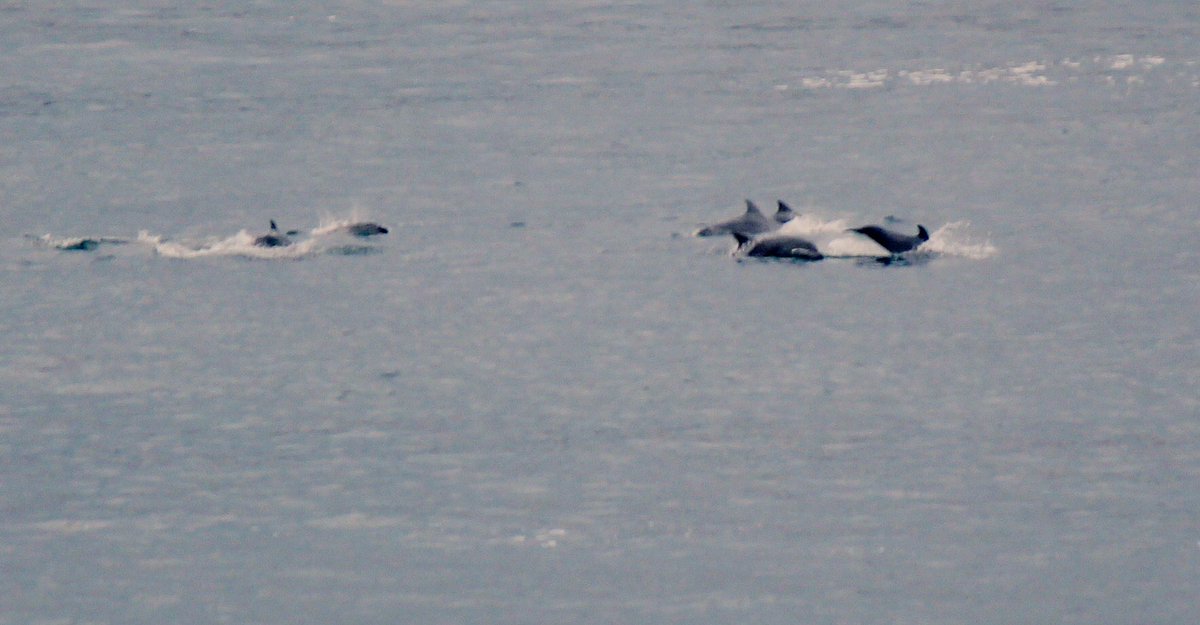
Pod of dolphins swam through the Bosphorus: image via Yörük Isik @YorukIsik, 7 April 2017
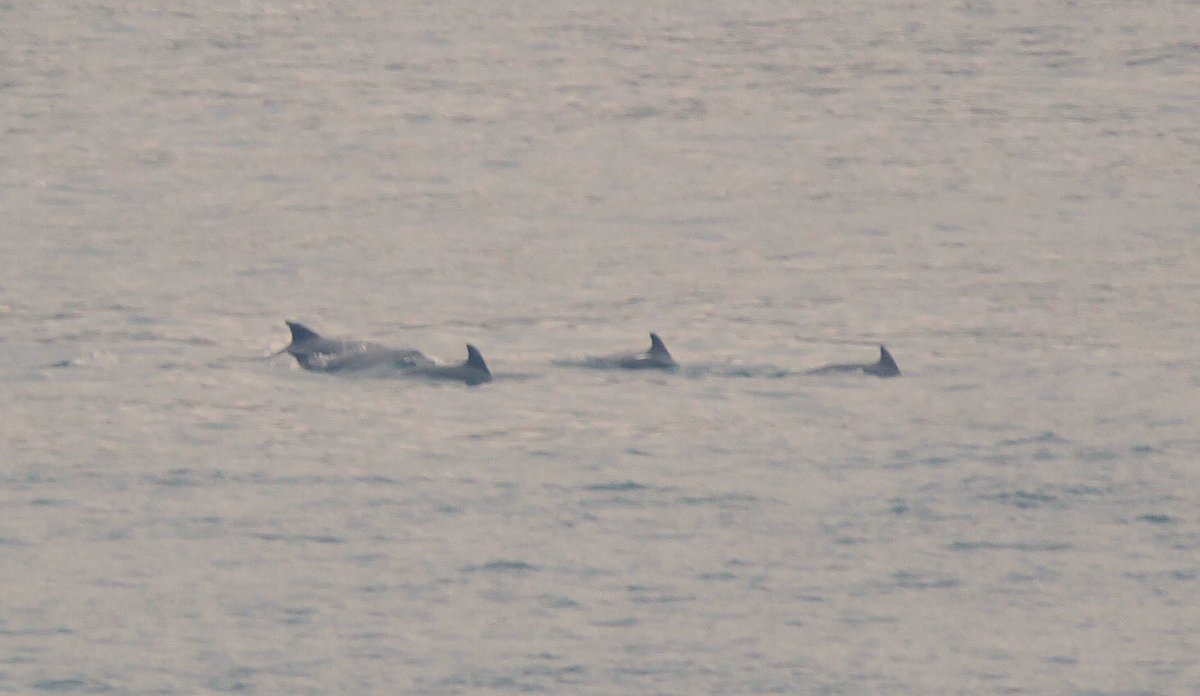
Pod of dolphins swam through the Bosphorus: image via Yörük Isik @YorukIsik, 7 April 2017
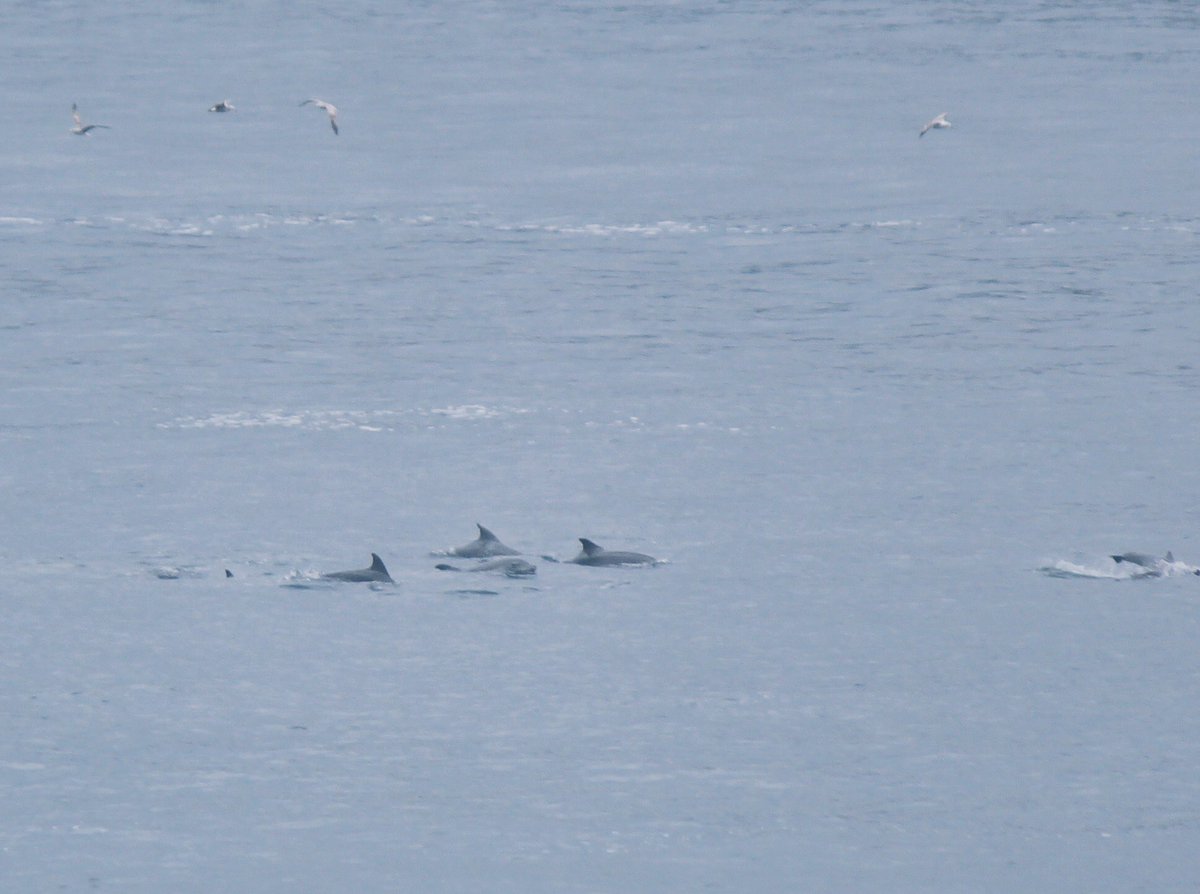
Pod of dolphins swam through the Bosphorus: image via Yörük Isik @YorukIsik, 7 April 2017
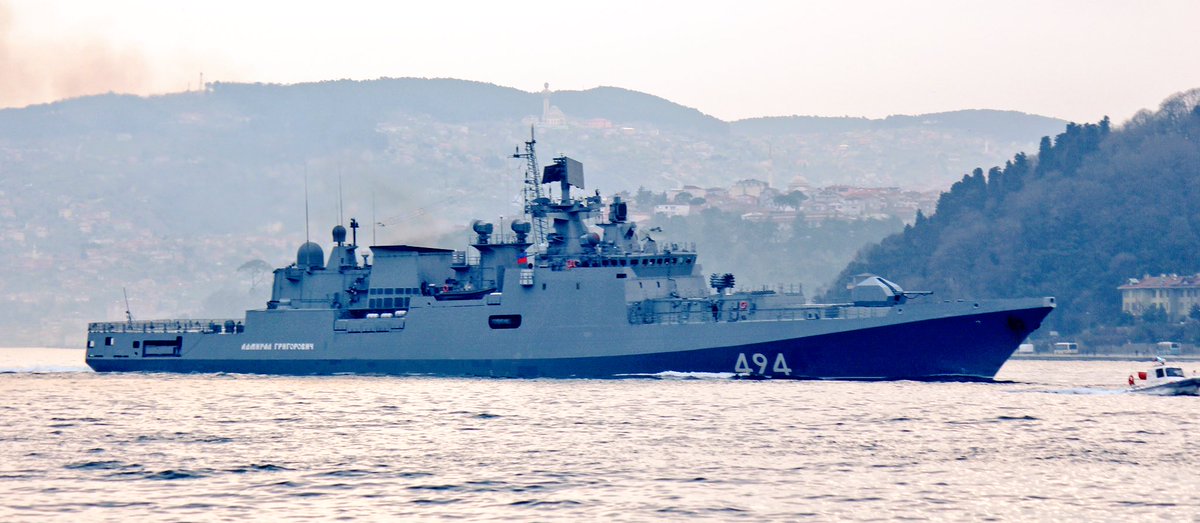
FAST TURNAROUND; Redeployed to Eastern Mediterranean in 9 days: #ВМФ #ЧФ frigate Admiral Grigorovich departs BlackSea and transits Bosphorus: image via Yörük Isik @YorukIsik, 6 April 2017
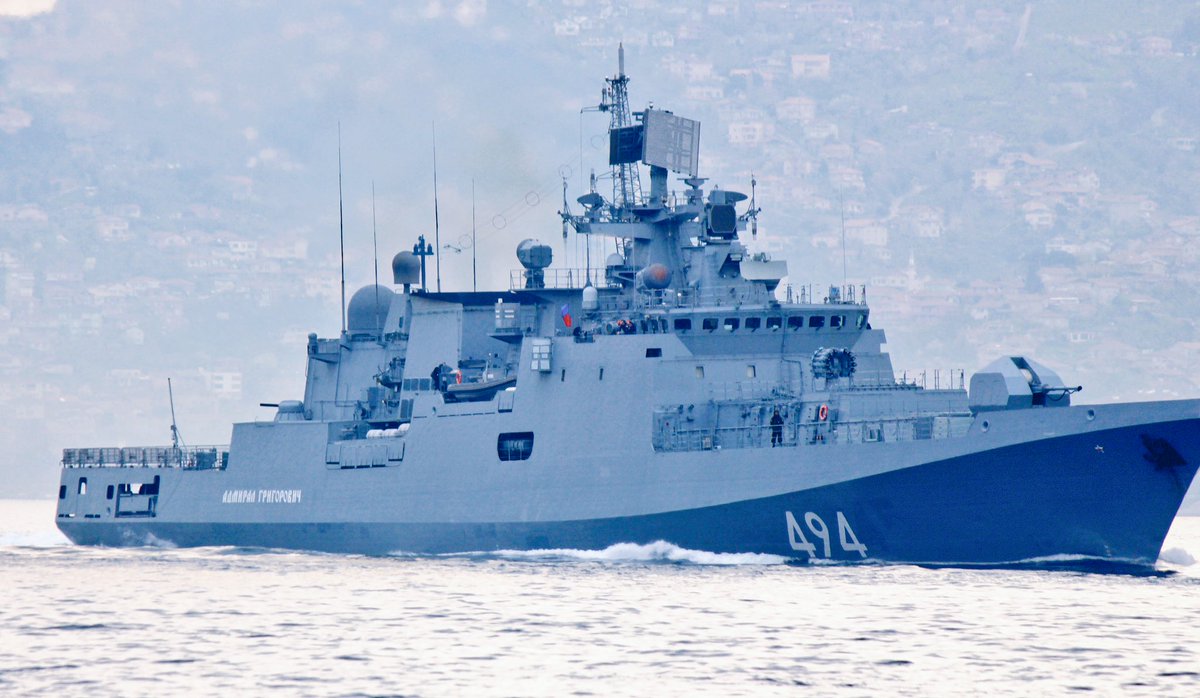
FAST TURNAROUND; Redeployed to Eastern Mediterranean in 9 days: #ВМФ #ЧФ frigate Admiral Grigorovich departs BlackSea and transits Bosphorus: image via Yörük Isik @YorukIsik, 6 April 2017
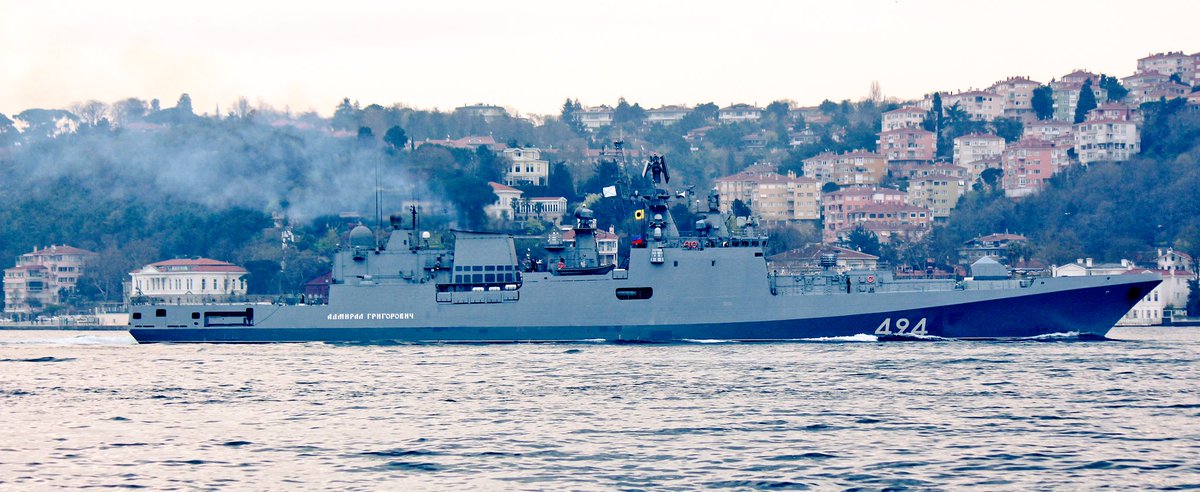
FAST TURNAROUND; Redeployed to Eastern Mediterranean in 9 days: #ВМФ #ЧФ frigate Admiral Grigorovich departs BlackSea and transits Bosphorus: image via Yörük Isik @YorukIsik, 6 April 2017
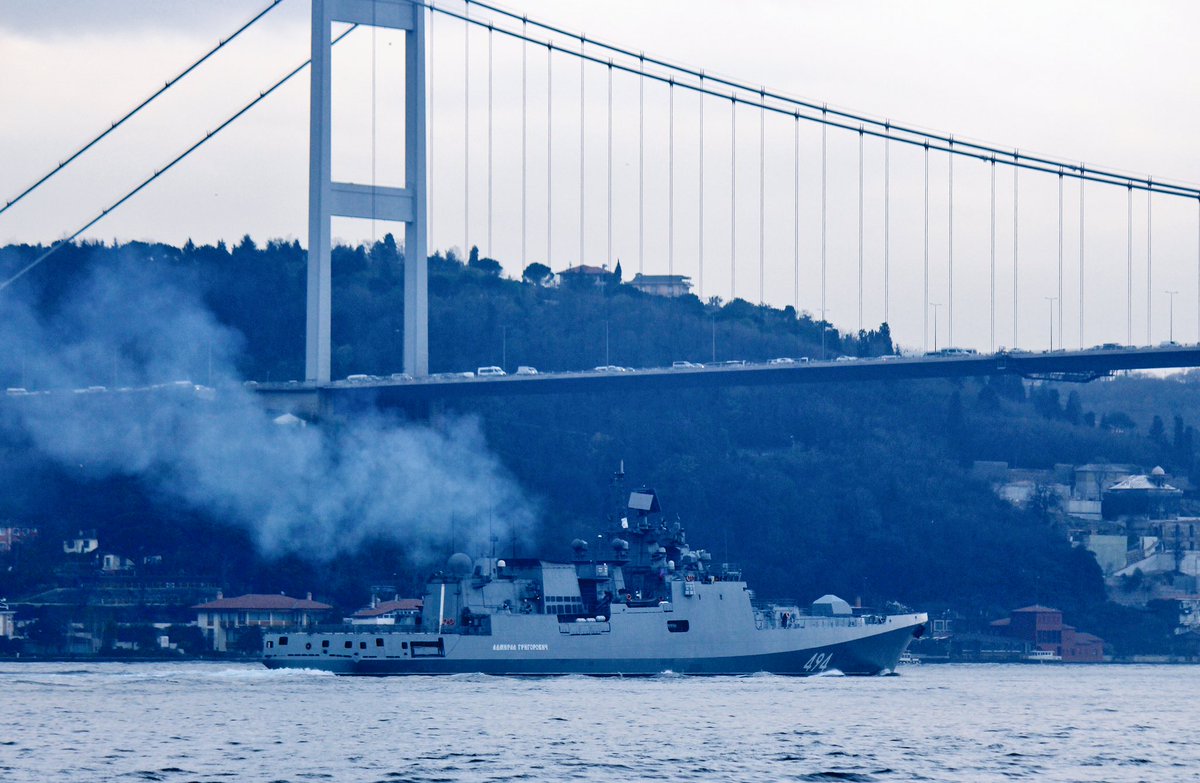
FAST TURNAROUND; Redeployed to Eastern Mediterranean in 9 days: #ВМФ #ЧФ frigate Admiral Grigorovich departs BlackSea and transits Bosphorus: image via Yörük Isik @YorukIsik, 6 April 2017

Istanbul: More storks return today, crossing Bosphorus from SE to NW @bosphorusbirds @LeylekGocu @SerhatGuvenc @rscudderboom @WALLSTAM: image via Yörük Isik @YorukIsik, 5 April 2017
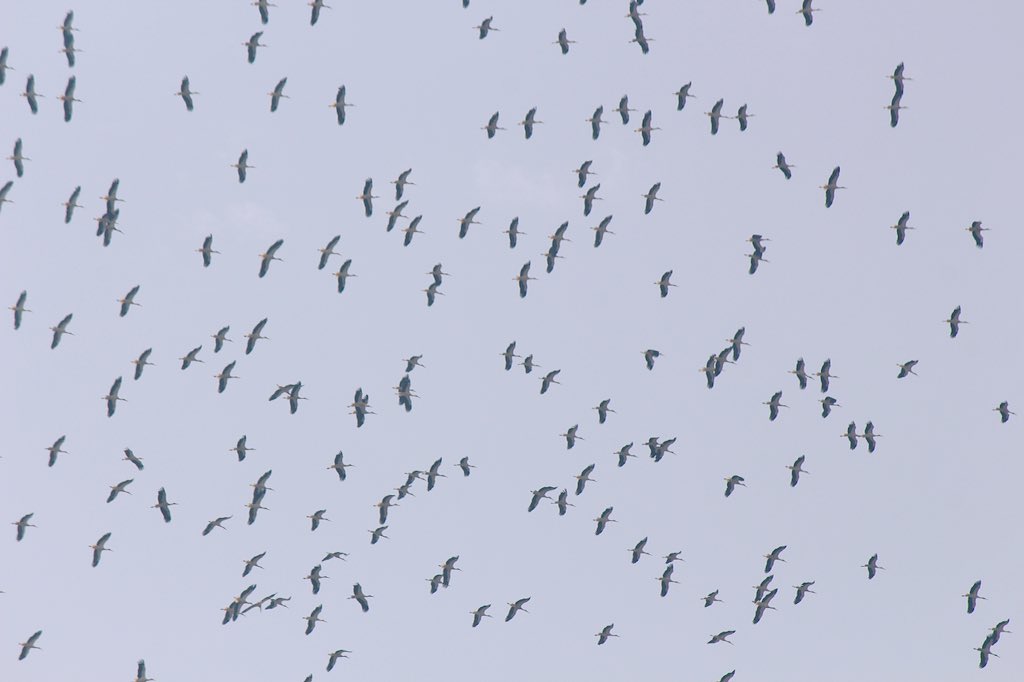
Istanbul: More storks return today, crossing Bosphorus from SE to NW @bosphorusbirds @LeylekGocu @SerhatGuvenc @rscudderboom @WALLSTAM: image via Yörük Isik @YorukIsik, 5 April 2017

Istanbul: More storks return today, crossing Bosphorus from SE to NW @bosphorusbirds @LeylekGocu @SerhatGuvenc @rscudderboom @WALLSTAM: image via Yörük Isik @YorukIsik, 5 April 2017
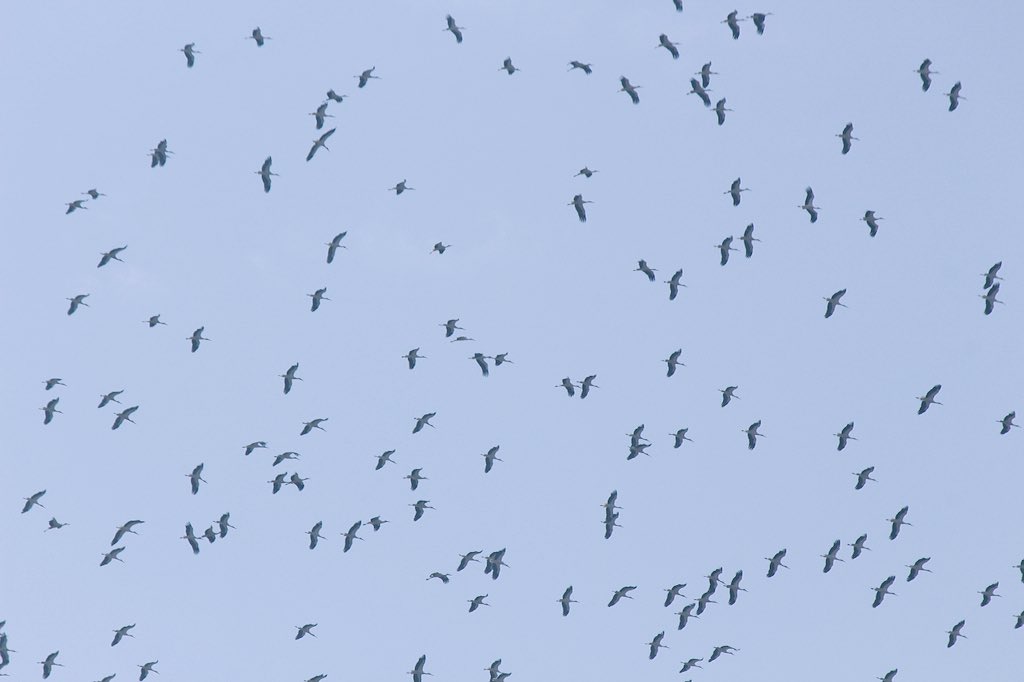
Istanbul: More storks return today, crossing Bosphorus from SE to NW @bosphorusbirds @LeylekGocu @SerhatGuvenc @rscudderboom @WALLSTAM: image via Yörük Isik @YorukIsik, 5 April 2017
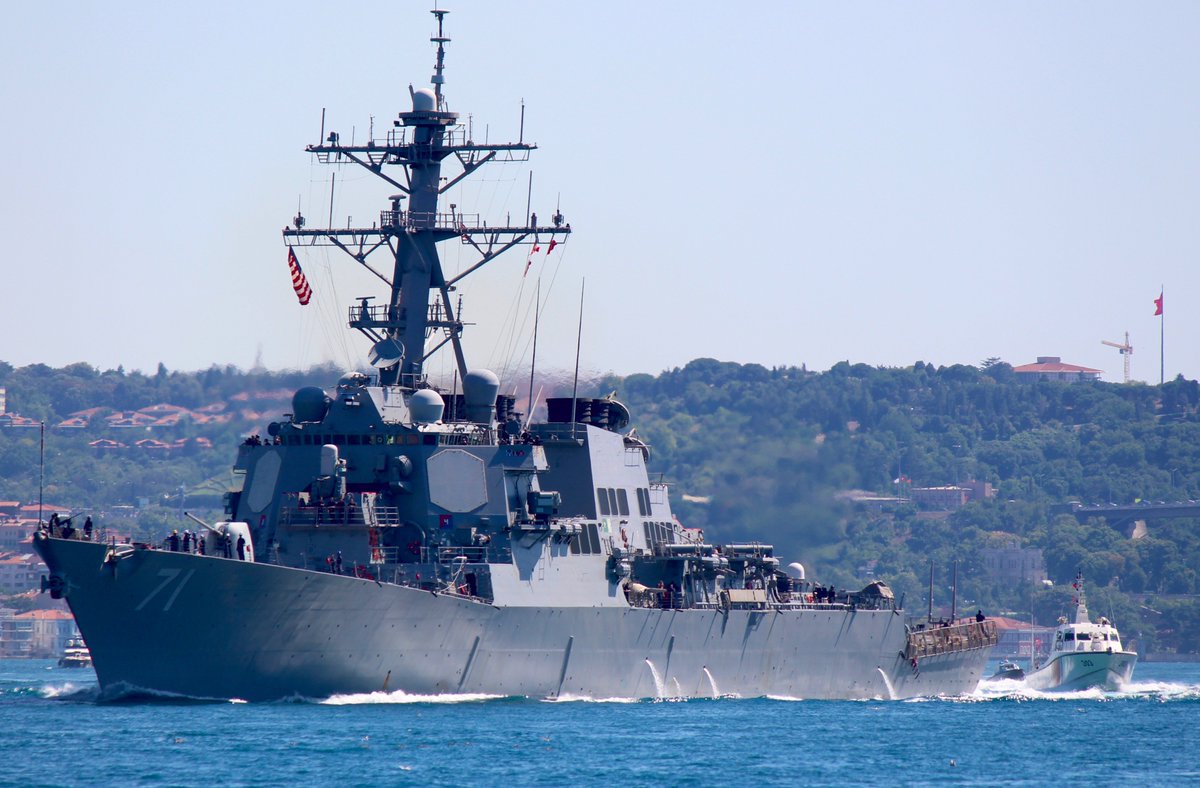
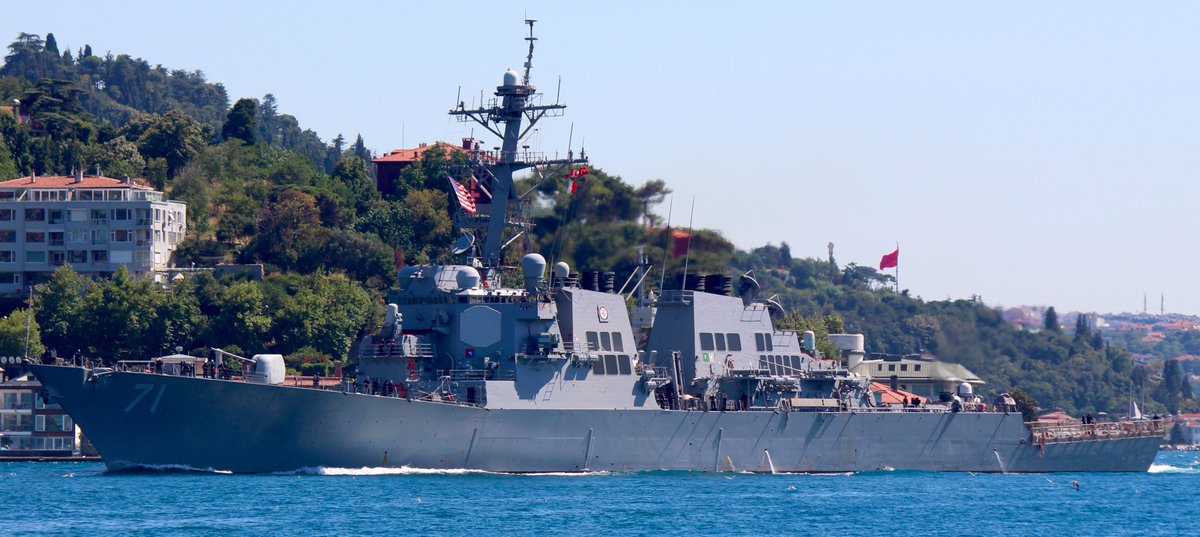
Arleigh Burke-class guided missile destroyer USS Ross DDG71 transits Bosphorus and enters the Black Sea #SeaBreeze2016: image via Yörük Isik @YorukIsik, 7 April 2017
#Russian
guided missile frigate Admiral #Grigorovich has once again passed the
#Bosphorus and is heading back to #Tartus, #Syria @YorukIsik: image via Witek Klec Pilewski @WitekPilewski, 7 April 2017
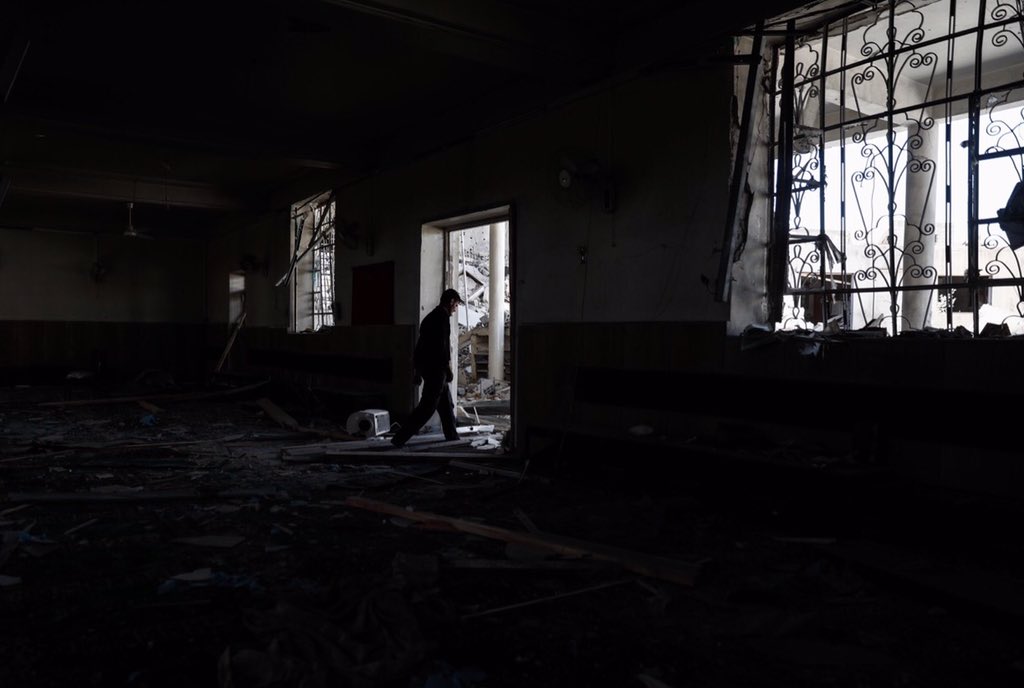
People inspect the damaged #mosque after an airstrike by the Syrian government forces on the city of #Douma. Ph: @SameerAlDoumy: image via Sameer Al-Doumy @SameerAlDoumy, 4 April 2017
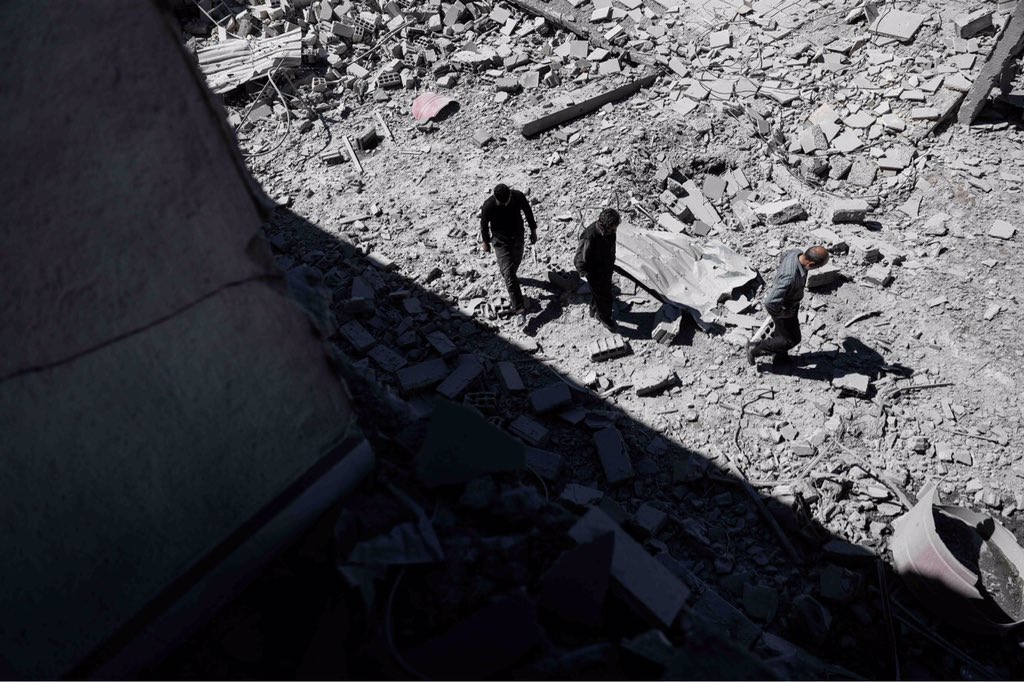
People inspect the damaged #mosque after an airstrike by the Syrian government forces on the city of #Douma. Ph: @SameerAlDoumy: image via Sameer Al-Doumy @SameerAlDoumy, 4 April 2017
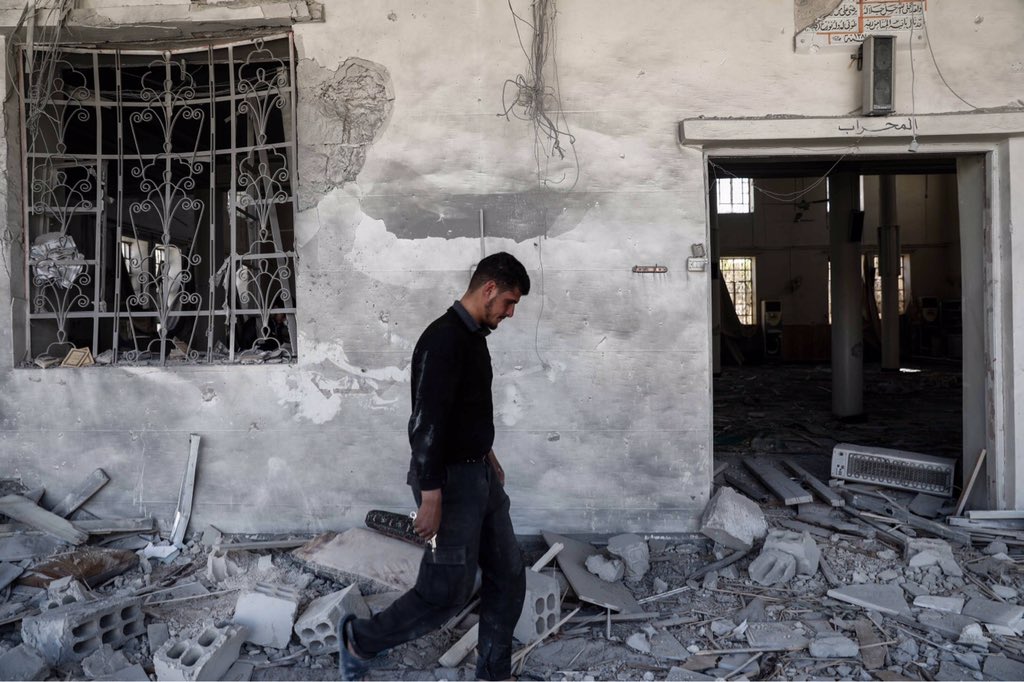
People inspect the damaged #mosque after an airstrike by the Syrian government forces on the city of #Douma. Ph: @SameerAlDoumy: image via Sameer Al-Doumy @SameerAlDoumy, 4 April 2017
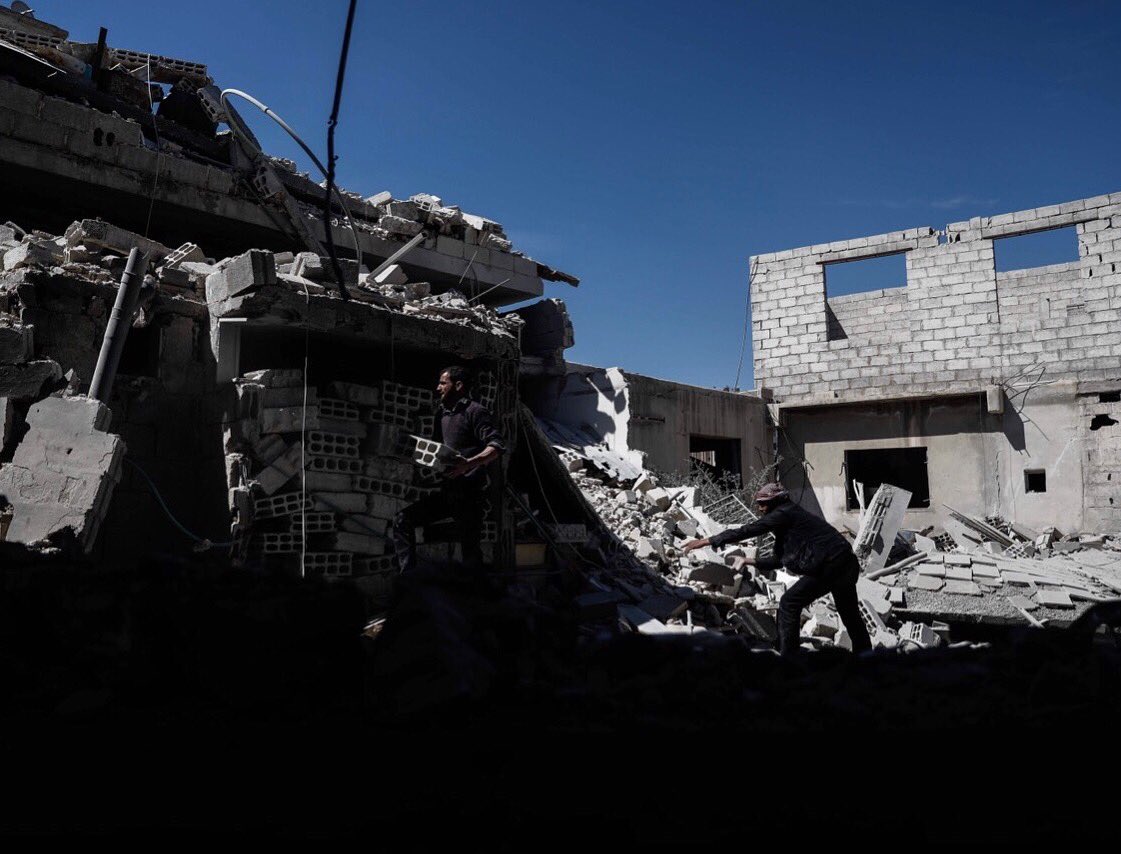
Syrian men building a wall for their destroyed house following an airstrike by the Syrian regime on the city of #Douma. Ph: @SameerAlDoumy: image via Sameer Al-Doumy @SameerAlDoumy, 4 April 2017
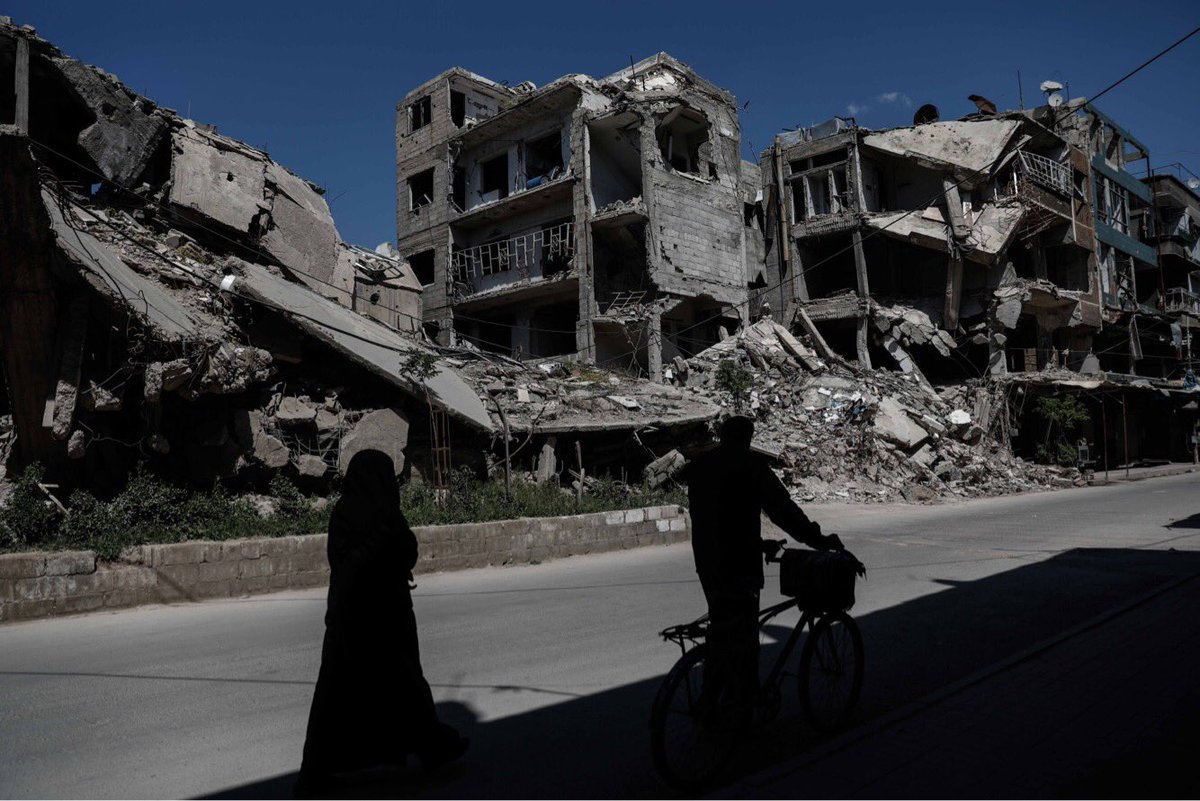
Syrians walk near past damaged buildings in the city of #Douma. Ph: @SameerAlDoumy: image via Sameer Al-Doumy @SameerAlDoumy, 7 April 2017
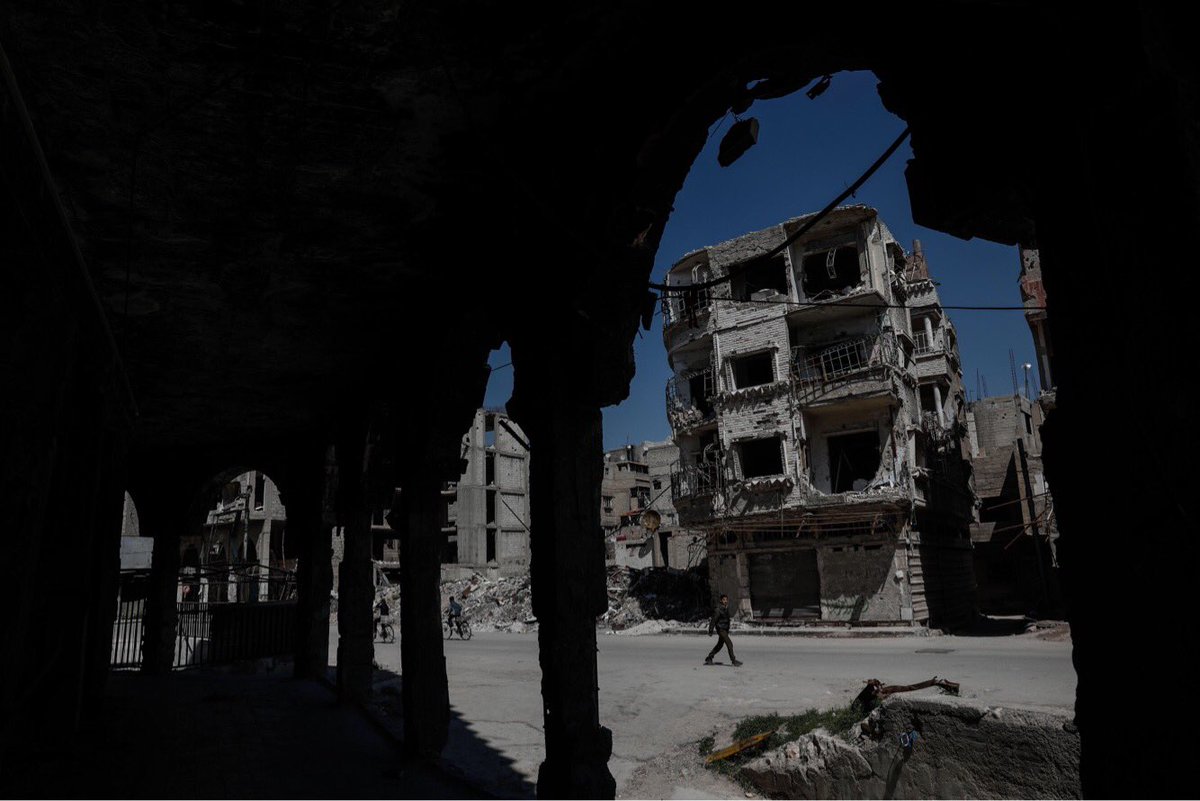
Syrians walk near past damaged buildings in the city of #Douma. Ph: @SameerAlDoumy: image via Sameer Al-Doumy @SameerAlDoumy, 7 April 2017
Infant Amira died in a reported air strike on the rebel-held town of #Douma #Syria Photo @AbdDoumany: image via Aurelia BAILLY @Aurelia BAILLY, 8 April 2017
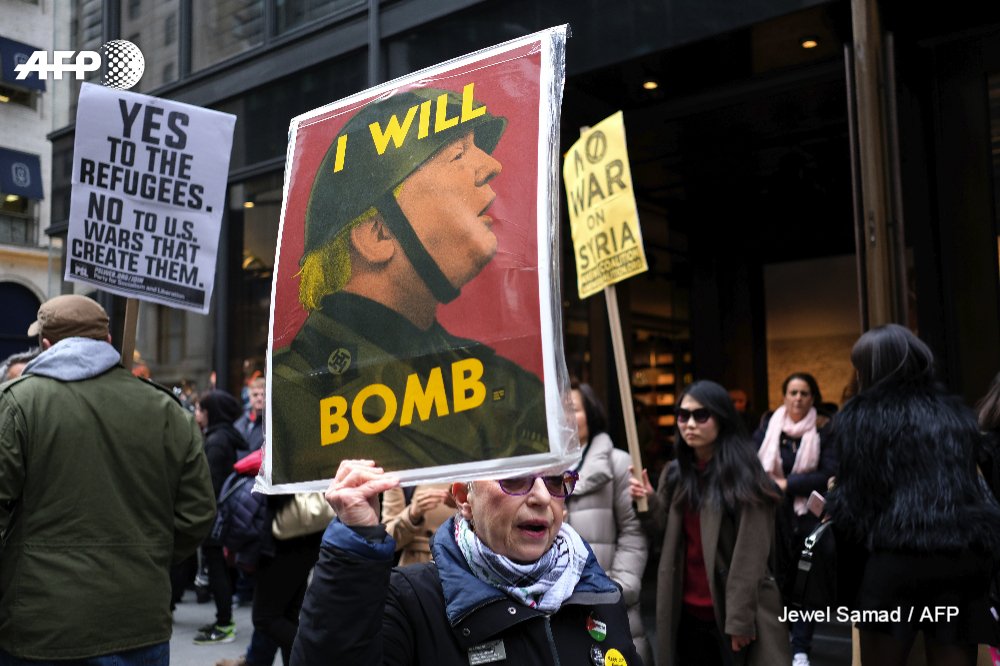
Anti-war demonstrators protest US airstrikes in Syria at Trump Tower in New York: image via AFP news agency @AFP, 7 April 2017
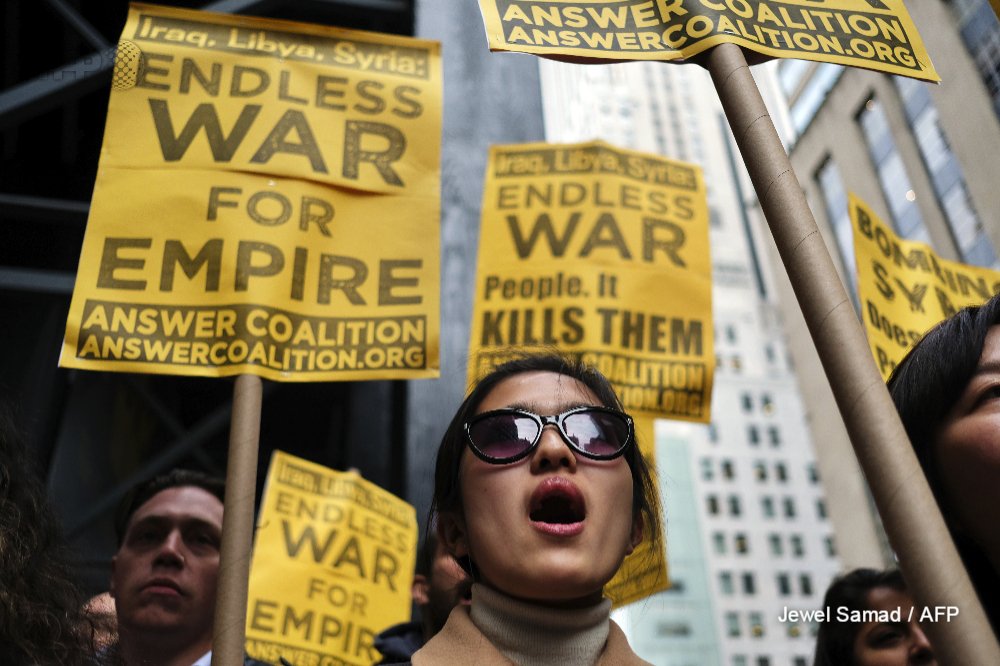
Anti-war demonstrators protest US airstrikes in Syria at Trump Tower in New York: image via AFP news agency @AFP, 7 April 2017

Anti-war demonstrators protest US airstrikes in Syria at Trump Tower in New York: image via AFP news agency @AFP, 7 April 2017
An Indian scavenger looks for recyclable items on the banks of the polluted Yamuna River. Photo Dominique Faget: image via Aurelia BAILLY @Aurelia BAILLY, 8 April 2017
Oswald Spengler: Der Untergang des Abendlandes (The Decline of the West), first edition cover: C.H. Beck Verlag, München, 1922: image by Perceval, 2005
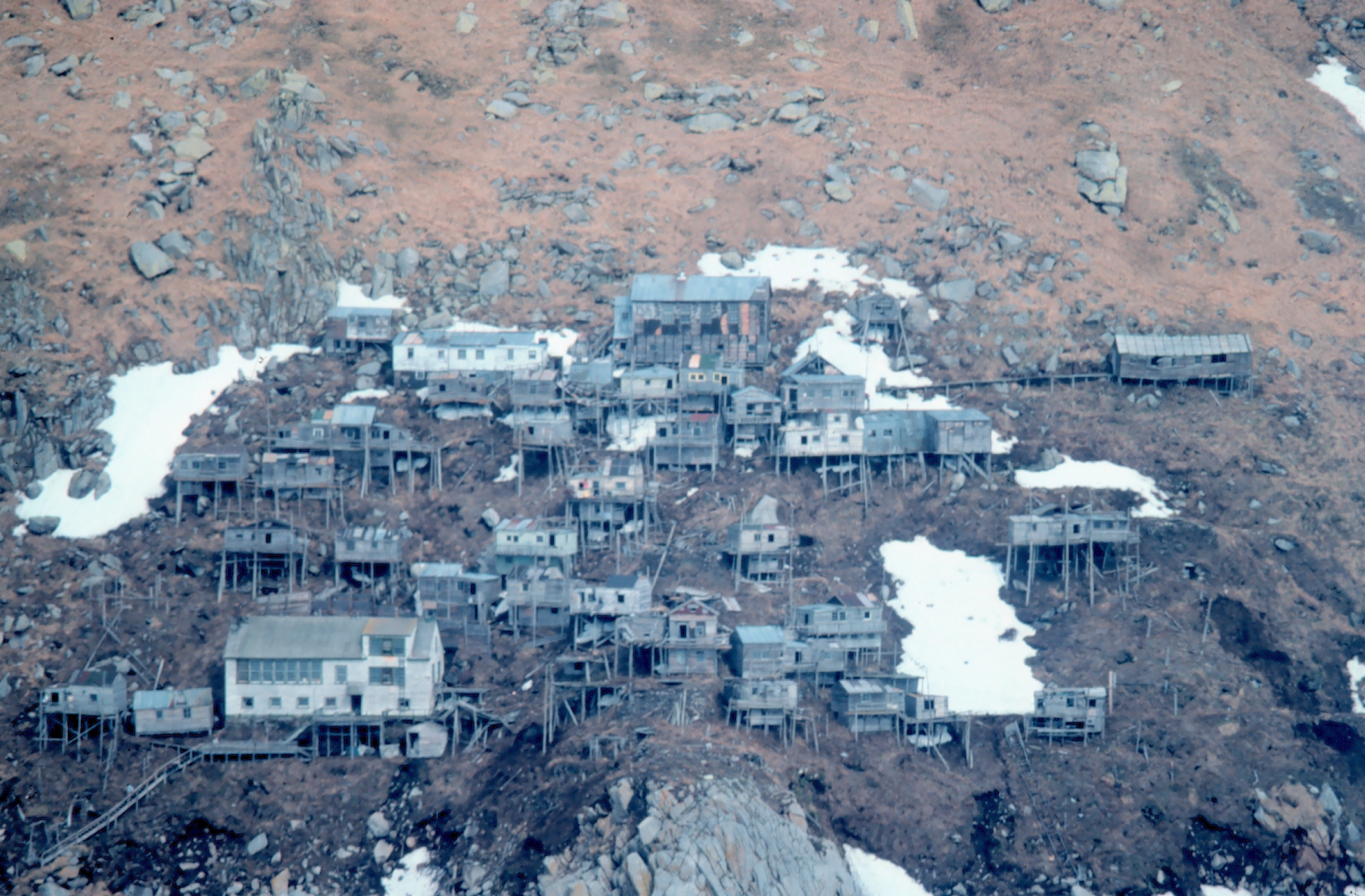
Deserted stilt village of Utivok, King Island, Bering Strait: photo by Capt. Budd Christman, 1978 (NOAA)
From August 22 to August 24, 1992 violent xenophobic riots took place in the Lichtenhagen district of Rostock, Germany; these were the worst mob attacks against migrants in postwar Germany. Even though stones and petrol bombs were thrown at an apartment block where asylum seekers lived, no one was killed. At the height of the riots, several hundred militant right-wing extremists were involved, and about 3,000 neighbourhood onlookers stood by, applauding them.
Between August 22 and 26, 1992, there were 370 provisional arrests and 408 preliminary investigations related to the riots. Among the arrested were 110 people from former West German, 217 from the state of Mecklenburg-Vorpommern, including 147 from Rostockand another 37 from the former East Germany. During the riot, 204 police officers were injured.
I Will Bomb

People inspect the damaged #mosque after an airstrike by the Syrian government forces on the city of #Douma. Ph: @SameerAlDoumy: image via Sameer Al-Doumy @SameerAlDoumy, 4 April 2017

People inspect the damaged #mosque after an airstrike by the Syrian government forces on the city of #Douma. Ph: @SameerAlDoumy: image via Sameer Al-Doumy @SameerAlDoumy, 4 April 2017

People inspect the damaged #mosque after an airstrike by the Syrian government forces on the city of #Douma. Ph: @SameerAlDoumy: image via Sameer Al-Doumy @SameerAlDoumy, 4 April 2017

Syrian men building a wall for their destroyed house following an airstrike by the Syrian regime on the city of #Douma. Ph: @SameerAlDoumy: image via Sameer Al-Doumy @SameerAlDoumy, 4 April 2017

Syrians walk near past damaged buildings in the city of #Douma. Ph: @SameerAlDoumy: image via Sameer Al-Doumy @SameerAlDoumy, 7 April 2017

Syrians walk near past damaged buildings in the city of #Douma. Ph: @SameerAlDoumy: image via Sameer Al-Doumy @SameerAlDoumy, 7 April 2017
I Will Bomb

Anti-war demonstrators protest US airstrikes in Syria at Trump Tower in New York: image via AFP news agency @AFP, 7 April 2017

Anti-war demonstrators protest US airstrikes in Syria at Trump Tower in New York: image via AFP news agency @AFP, 7 April 2017

Anti-war demonstrators protest US airstrikes in Syria at Trump Tower in New York: image via AFP news agency @AFP, 7 April 2017
Down-Going of the Evening-Lands
Oswald Spengler: Der Untergang des Abendlandes (The Decline of the West), first edition cover: C.H. Beck Verlag, München, 1922: image by Perceval, 2005

Deserted stilt village of Utivok, King Island, Bering Strait: photo by Capt. Budd Christman, 1978 (NOAA)
You Are Germany (White Power Pogrom @ Sunflower Tower, Rostock-Lichtenhagen, 1992)
From August 22 to August 24, 1992 violent xenophobic riots took place in the Lichtenhagen district of Rostock, Germany; these were the worst mob attacks against migrants in postwar Germany. Even though stones and petrol bombs were thrown at an apartment block where asylum seekers lived, no one was killed. At the height of the riots, several hundred militant right-wing extremists were involved, and about 3,000 neighbourhood onlookers stood by, applauding them.
The initial response of authorities and politicians was heavily criticised. For some days prior to the riots, veiled warnings of impending trouble had been posted in some newspapers. Police and politicians seemed reluctant to respond and when they did, their response was inadequate to meet the need. Outside the building where the refugees were housed, several hundred
asylum seekers had been camping for several days with little or no
access to basic facilities, contributing to escalating tensions in the
neighbourhood.
Between August 22 and 26, 1992, there were 370 provisional arrests and 408 preliminary investigations related to the riots. Among the arrested were 110 people from former West German, 217 from the state of Mecklenburg-Vorpommern, including 147 from Rostockand another 37 from the former East Germany. During the riot, 204 police officers were injured.
The Zentrale Aufnahmestelle für Asylbewerber für Mecklenburg-Vorpommern (ZAst M-V), or "Central Refugee Shelter" for the state of Mecklenburg-Vorpommern, was in an 11-storey plattenbau
apartment complex known as the "Sunflower House" or "Sunflower Tower",
because of the large sunflowers decorating one side. The building was
notorious for the inhumane conditions under which the asylum seekers
there were living and the lack of much (or any) support for them. The
authorities ignored the numerous complaints from citizens and residents
over the filthy and deplorable conditions in the apartment building.
The
shelter was originally intended to house 300 refugees a month, but by
summer 1992 it was averaging 11,500 refugees per month. Primarily Roma from Romania,
they were left by overstretched shelter staff to camp out in front of
the building for days at a time. The municipal government refused to
provide portable toilets and there was no water or garbage collection.
Clashes between the homeless migrants and the Lichtenhagen residents
increased. Neither the city nor the state government took action.
For days prior to the riots, the newspapers Norddeutche Neueste Nachrichten and Ostsee-Zeitung
had been calling for a "Lichtenhagen interest group". There were
anonymous warnings that if by the weekend, the refugee shelter was not
"cleaned up," order would be made. This gave young gang members
from every corner of Rostock, normally enemies, a date, place and
purpose to congregate. One 19-year-old skinhead said, "The police know
the Rostock Skins and 'Hools' [hooligans]. When something like this is
announced, we're there!"
The
first day's riot started with young people from the neighbourhood
throwing stones. This was contained by the police, but media coverage
encouraged neo-nazis to roam the area. This led to a situation where a
xenophobic
mob outnumbered the police by day three. The original target, the
asylum accommodation, was evacuated on the second day, whereupon the mob
stormed a neighbouring building in which 115 Vietnamese immigrants, a
social worker and a ZDF
television crew had mistakenly been left behind. While the building
burned, they barricaded their doors against rioters, who were climbing
over the balconies armed with baseball bats and Molotov cocktails.
Below, a mob of over 5,000 spectators eagerly watched and applauded.
Charges
of police and political incompetence were levelled from the
beginning. One explanation cited for the lack of effective action by the
police was that they were reluctant to take any action which might have
been reminiscent of the recently cast-off communist police state. There
were also charges that police and politicians were privately
sympathetic to the anti-migrant sentiment.
The first major conviction relating to the riots was on March 4,
1993, though 24 convictions on lesser charges had already been handed
down. A 22-year-old man was convicted of throwing a firebomb at police,
of seriously disturbing the peace, violating weapons laws and attempted
bodily harm. An attempted murder charge was dropped for lack of
evidence. Critics complained that no one was convicted of assaulting a
foreigner, only of assaulting the police or of disorderliness. It took almost ten years to prosecute 408 people.
(Wikipedia)
Anschlag auf ein Asylbewerberheim: Neonazis und Sympathisanten werfen unter dem Applaus des Mobs Brandbomben auf ein Asylbewerberheim in Rostock-Lichtenhagen im August 1992. Scheiben zerbersten klirrend, Balkone und Wohnungen gehen in Flammen auf. 115 vietnamesische Flüchtlinge befanden sich zu der Zeit des Angriffs in dem Gebäude.: photo by AP via Spiegel Online
Feuerwehrmann in Rostock: Ein Feuerwehrmann versucht der in der fünften Krawallnacht in der Nähe des inzwischen geräumten Asylbewerberheims Rostock-Lichtenhagen, den von rechten Extremisten in Brand gesteckten Pkw eines Anwohners zu löschen. Die Brandstifter hinderten die alarmierte Feuerwehr daran, zu dem brennenden Haus vorzudringen. Im dichten Steinhagel müssen sich die Feuerwehrmänner wieder zurückziehen, bis sie endlich löschen können.: photo by AP via Spiegel Online
Nach den brutalen Ausschreitungen: Der Mob attackierte das Hochhaus Nummer 19, ein Wohnheim für Vietnamesen, die zum Teil als DDR-Vertragsarbeiter nach Rostock gekommen waren. Ein Großteil brannte nieder. Auf dem Foto ist einer der völlig ausgebrannten Räume des Hauses zu sehen, das neben dem von Randalierern in Brand gesetzten Asylbewerberheim steht. Vom 22. bis 28. August 1992 randalierten in Rostock-Lichtenhagen bis zu 1200 meist jugendliche rechtsradikale Gewalttäter vor dem Zentralen Asylbewerberheim.: photo by DPA via Spiegel Online
Nach dem Anschlag : Blick auf das von über 100 Vietnamesen bewohnte Haus neben dem Asylbewerberheim, das vor einem johlenden und applaudierenden Mob von Randalierern in Brand gesetzt wurde. Vom 22. bis 28. August 1992 randalierten bis zu 1200 meist jugendliche rechtsradikale Gewalttäter vor dem Zentralen Asylbewerberheim Mecklenburg-Vorpommern in Rostock-Lichtenhagen. Die Bilder gingen um die Welt. Rostock wurde ählich wie Hoyerswerda oder Solingen zum Synonym für ein Deutschland, in dem Ausländer um ihr Leben fürchten müssen. Bis heute kämpft die Hansestadt darum, ihr Image geradezurücken.: photo by DPA via Spiegel Online
Beginn des Lichtenhagen-Prozesses: Die Angeklagten Ronny S. (l.) mit Anwalt Ulrich Knye (2.v.l.), Andre B. (3.v.l.) mit Anwalt Andreas Roter (4.v.l.) und Enrico P. (r.) erheben sich zu Beginn des sogenannten Lichtenhagen-Prozesses im Schweriner Landgericht von ihren Plätzen. Neun Jahre nach den Brandanschlägen auf ein Ausländerwohnheim im Rostocker Stadtteil Lichtenhagen mussten sich die drei Männer im Alter von inzwischen 26 bis 28 Jahren wegen versuchten Mordes, schweren Landfriedensbruchs und schwerer Brandstiftung verantworten. Zum Auftakt des Prozesses forderten die Verteidiger die Einstellung des Verfahrens für zwei der Angeklagten. Als Grund nannten sie vor dem Landgericht Schwerin übereinstimmend die lange Dauer des Verfahrens.: photo by DPA via Spiegel Online
In the minds of many, it was precisely what should have been done at the outset. Chancellor Helmut Kohl's right-hand man in the Christian Democrats, Wolfgang Schauble said: 'The police behaviour did little to underpin the citizen's confidence in the effectiveness of the state.'
On all sides, it is admitted 'mistakes were made'. If the police had acted speedily and decisively, there is a good chance that the rioting around the refugee hostel on the council estate of Rostock-Lichtenhagen would not have increased into the worst racist violence since unification.
There are several explanations for the insufficient security, none of them comforting for the authorities. The first is that they were unprepared for this sort of violence. Certainly, in Communist times, the East German police had little experience of this sort of street-fighting.
The first shocking assault on a foreigner hostel, when local inhabitants also stood around cheering on neo-Nazis, occurred nearly a year ago, in the eastern German town of Hoyerswerda. Then, stunned politicians said the warnings would be heeded and the unprepared eastern police would be properly trained and equipped; such events, which shamed Germany in the eyes of the world, would not happen again. We have heard exactly the same phrases over the past few days.
A second, and more telling explanation, is that the police feel constrained in their use of the big stick. For unlike Hoyerswerda, the police in Rostock had the necessary anti-riot equipment. But there is a strong aversion in eastern Germany among the authorities to adopt tough measures which are felt to be reminiscent of the strong-arm Communist state. This insecurity is not helped by the wariness now prevalent among western German forces, such as the riot-police reinforcements brought into Rostock from Berlin and Hamburg.
The western German police have been badly burnt by the strong public outcries, and in the case of Hamburg, condemnation by court, following the bitter confrontations of the Eighties against left-wing demonstrators.
But there is another, more serious, explanation for the police failures in Rostock. It is not just the local police who, in those early, crucial stages of the violence, were constrained by obvious sympathies with the antiforeigner sentiments of the crowd.
The conservative state and city politicians were even more fearful of upsetting the populace. The first reaction to the riots by the CDU Interior Minister of Mecklenburg, Lothar Kupfer, in which he expressed 'certain understanding' for the thugs and the crowds that cheered them on, was revealing.
The Christian Democrats have a shaky hold on power in Mecklenburg, and they were not about to shake it any more by contradicting the mood on the streets. By the time shock had stiffened the politicians' resolve, it was too late.


Antifaschist Demo '20 Jahre nach dem Pogrom' am 25.08.12 in Rostock-Lichtenhagen: photo by Medien AG // Anarchistische Gruppe Freiburg, 25 July 2012

Antifaschist Demo '20 Jahre nach dem Pogrom' am 25.08.12 in Rostock-Lichtenhagen: photo by Medien AG // Anarchistische Gruppe Freiburg, 25 July 2012

Antifaschist Demo '20 Jahre nach dem Pogrom' am 25.08.12 in Rostock-Lichtenhagen: photo by Medien AG // Anarchistische Gruppe Freiburg, 25 July 2012

Rostock, Lichtenhagen.: photo by Lyd.ium, February 2017

Rostock, Lichtenhagen.: photo by Lyd.ium, February 2017

Rostock, Lichtenhagen.: photo by Lyd.ium, February 2017

Das Sonnenbluhmenhaus. Rostock, Lichtenhagen.: photo by Lyd.ium, February 2017

Das Sonnenbluhmenhaus. Rostock, Lichtenhagen.: photo by Lyd.ium, February 2017

Das Sonnenbluhmenhaus. Rostock, Lichtenhagen.: photo by Lyd.ium, February 2017

Rostock, Lichtenhagen.: photo by Lyd.ium, February 2017

Rostock, Lichtenhagen.: photo by Lyd.ium, February 2017

Refugee Accommodation "Tempohome". Berlin, Tempelhof.: photo by Lyd.ium, March 2017

Refugee Accommodation "Tempohome". Berlin, Tempelhof.: photo by Lyd.ium, March 2017

Refugee Accommodation "Tempohome". Berlin, Tempelhof.: photo by Lyd.ium, March 2017

Refugee Accommodation "Tempohome". Berlin, Tempelhof.: photo by Lyd.ium, March 2017

Refugee Accommodation "Tempohome". Berlin, Tempelhof.: photo by Lyd.ium, March 2017

Refugee Accommodation "Tempohome". Berlin, Tempelhof.: photo by Lyd.ium, March 2017

Berlin, Tempelhofer Field.: photo by Lyd.ium, February 2017

Baltic Sea, Germany: photo by Lyd.ium, February 2017

Warnemünde. Baltic Sea, Germany.: photo by Lyd.ium, February 2017

Warnemünde. Baltic Sea, Germany.: photo by Lyd.ium, February 2017

Baltic Sea, Germany.: photo by Lyd.ium, February 2017

Warnemünde. Baltic Sea, Germany.: photo by Lyd.ium, February 2017

Warnemünde. Baltic Sea, Germany.: photo by Lyd.ium, February 2017

Warnemünde. Baltic Sea, Germany.: photo by Lyd.ium, February 2017

Warnemünde. Baltic Sea, Germany.: photo by Lyd.ium, February 2017

Baltic Sea, Germany: photo by Lyd.ium, February 2017


[Untitled]: photo by Lyd.ium, February 2017



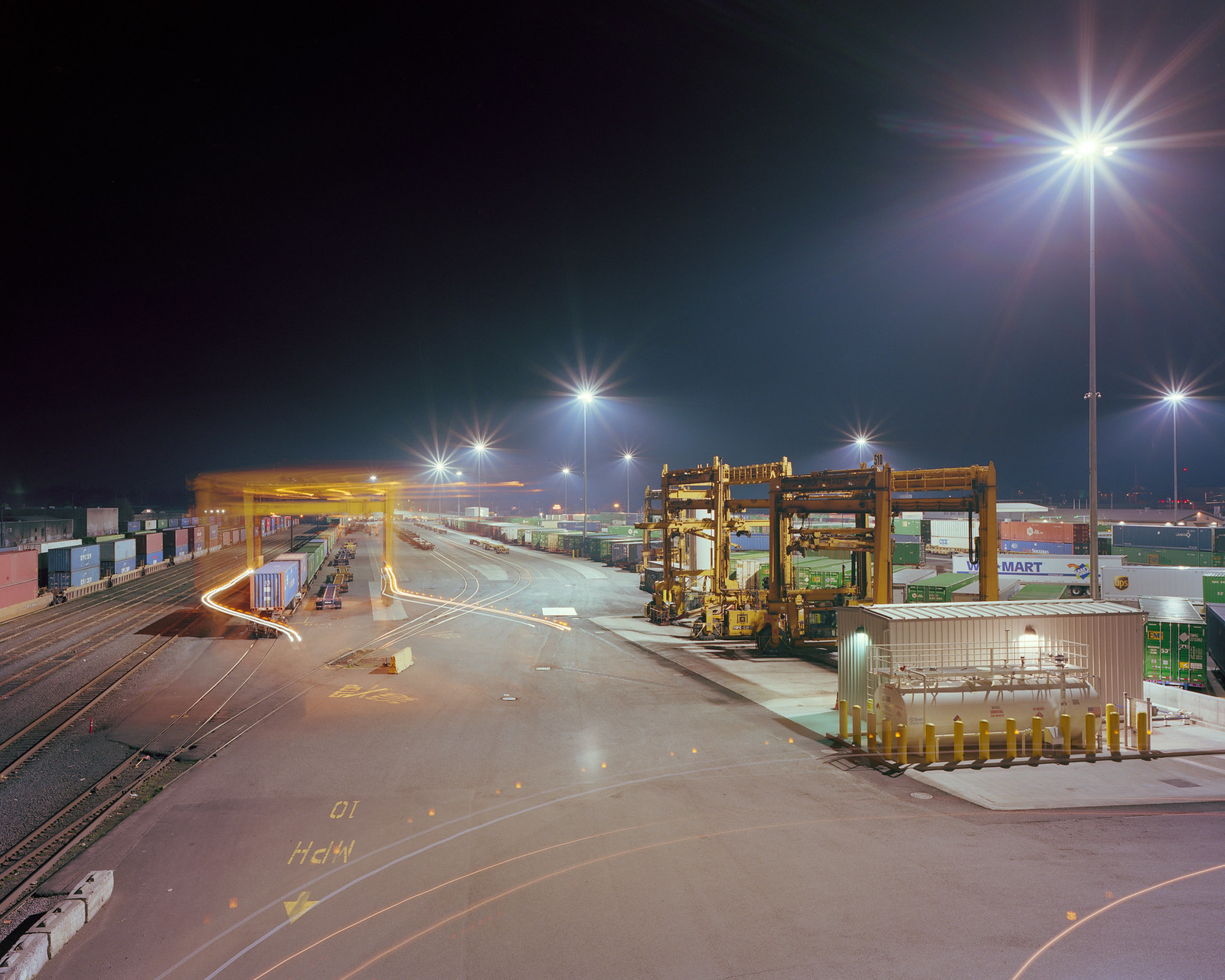
[Portland]: photo by Lucas DeShazer, 8 April 2017

[Portland]: photo by Lucas DeShazer, 8 April 2017

[Portland]: photo by Lucas DeShazer, 8 April 2017
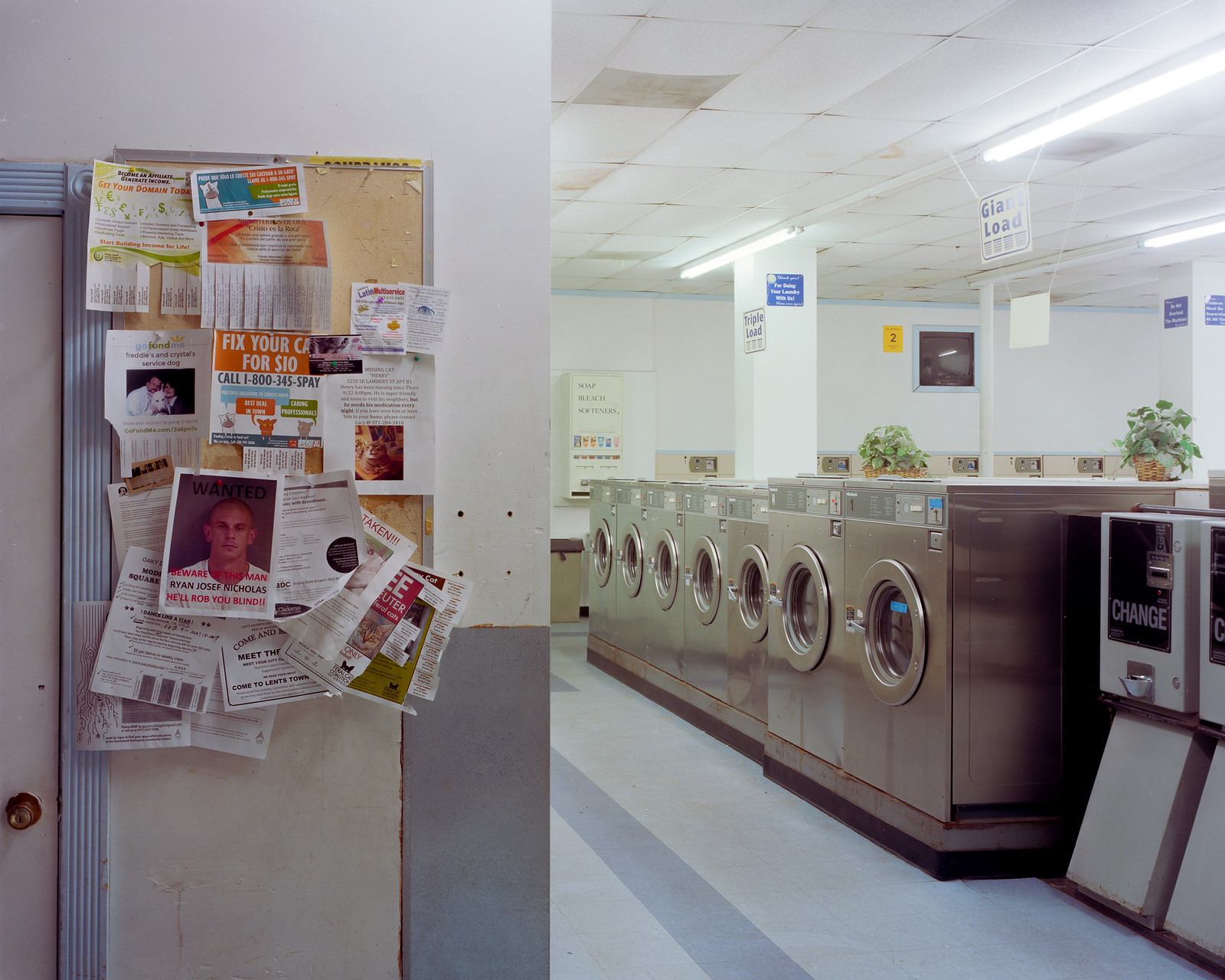
[Portland]: photo by Lucas DeShazer, 5 April 2017


[Portland]: photo by Lucas DeShazer, 5 April 2017
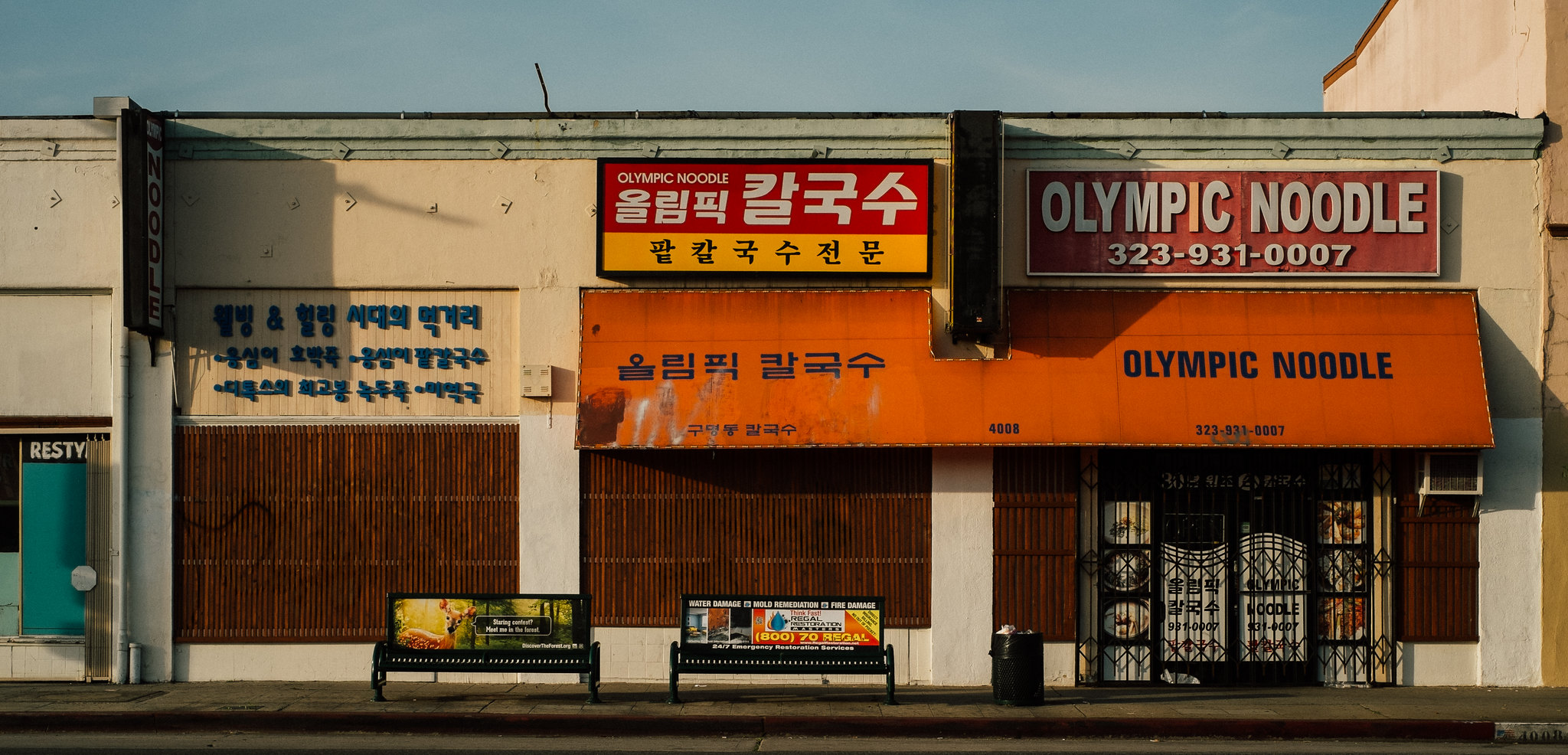
Noodles. K-Town.: photo by michaelj1998, 7 April 2017

Noodles. K-Town.: photo by michaelj1998, 7 April 2017

Noodles. K-Town.: photo by michaelj1998, 7 April 2017
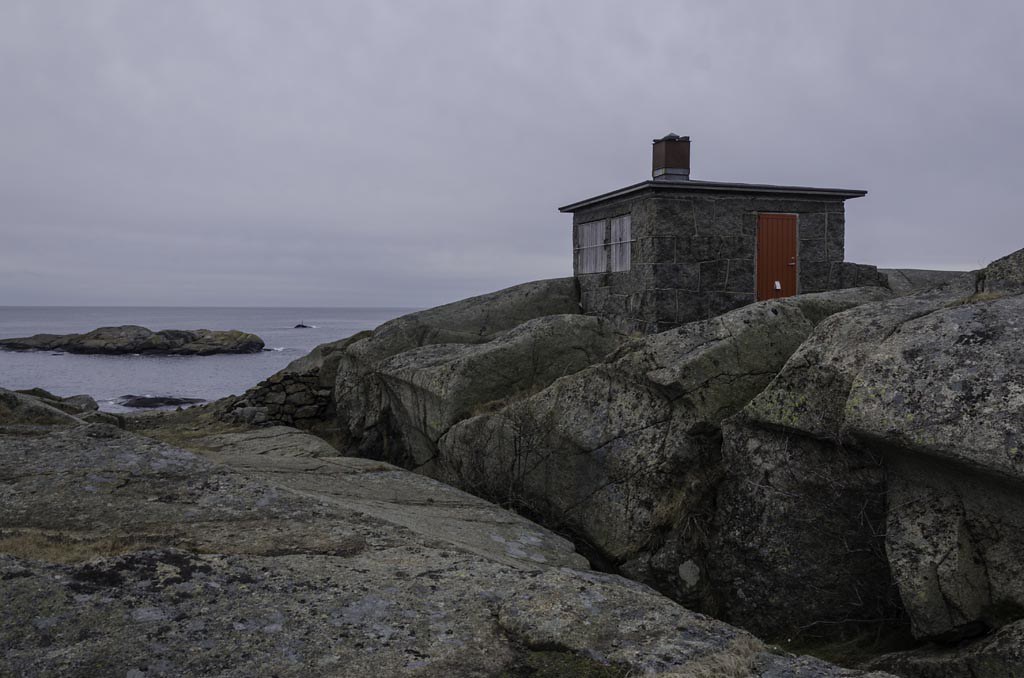
Stone hut [Larvik]: photo by astrid westvang, 19 March 2017

Foxton Beach, NZ.: photo by bobsan88, 11 February 2017

Westport, NZ.: photo by bobsan88, 7 April 2017

Levin, NZ.: photo by bobsan88, 12 February 2017

El Gato. Puerte de Tazacorte - La Palma [Canary Islands]: photo by Rasande Tyskar, 29 March 2017

El Gato. Puerte de Tazacorte - La Palma [Canary Islands]: photo by Rasande Tyskar, 29 March 2017

El Gato. Puerte de Tazacorte - La Palma [Canary Islands]: photo by Rasande Tyskar, 29 March 2017
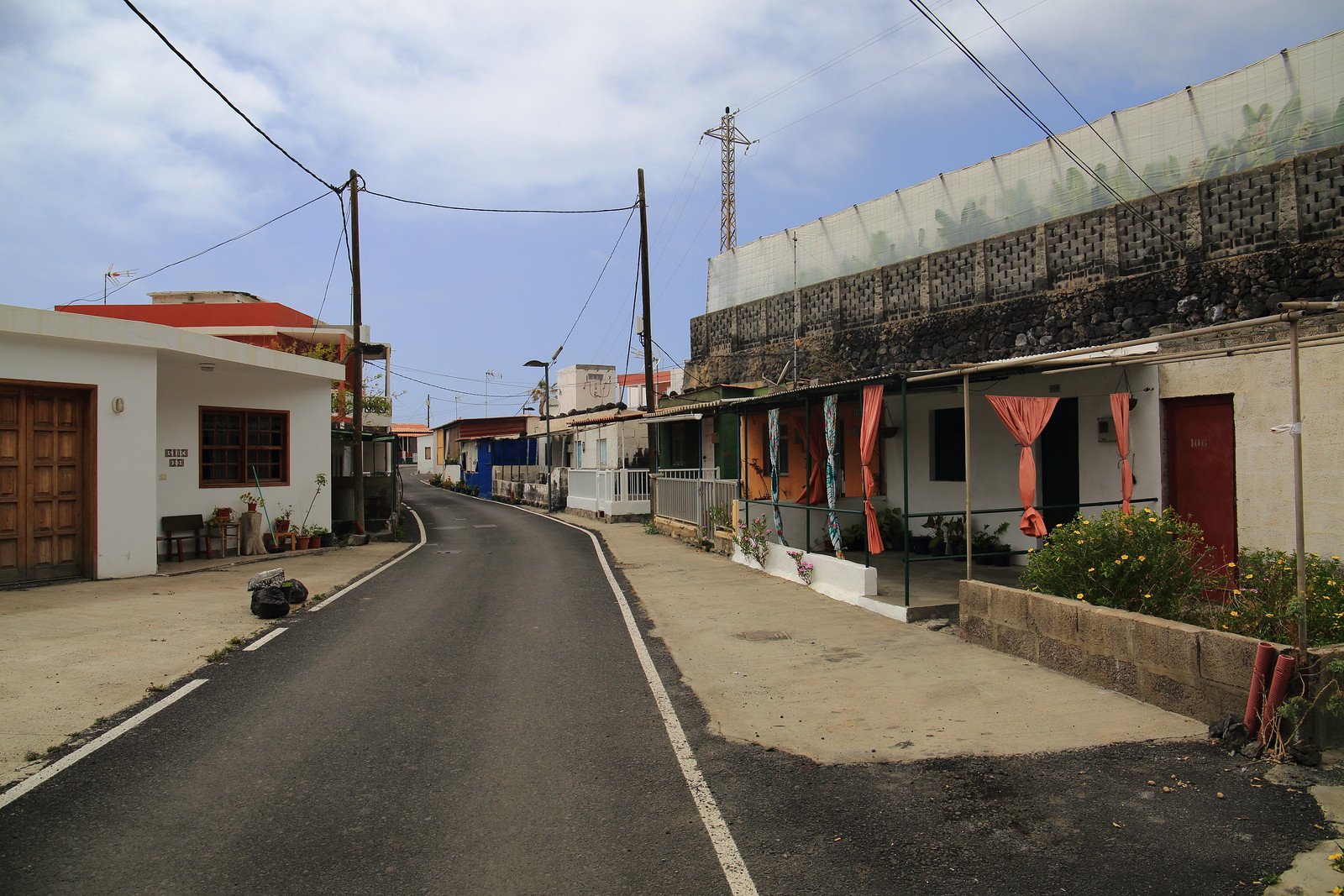

high noon at main street. El Remo - La Palma [Canary Islands]: photo by Rasande Tyskar, 3 April 2017

high noon at main street. El Remo - La Palma [Canary Islands]: photo by Rasande Tyskar, 3 April 2017
Straßenblockade in Rostock: Rostock-Lichtenhagen im August
1992, Rechtsradikale haben unter dem Applaus eines johlenden Mobs ein
Asylbewerberheim angegriffen, unter die Randalierer mischen sich
Neonazis aus Niedersachsen und Schleswig-Holstein. Polizei und Feuerwehr
werden durch die Menschenmenge an ihren Einsätzen gehindert.
Fernsehsender berichten mit Direktschaltungen vor Ort. Die Republik
sitzt entsetzt vor den Bildschirmen.: photo by AP via Spiegel Online
Anschlag auf ein Asylbewerberheim: Neonazis und Sympathisanten werfen unter dem Applaus des Mobs Brandbomben auf ein Asylbewerberheim in Rostock-Lichtenhagen im August 1992. Scheiben zerbersten klirrend, Balkone und Wohnungen gehen in Flammen auf. 115 vietnamesische Flüchtlinge befanden sich zu der Zeit des Angriffs in dem Gebäude.: photo by AP via Spiegel Online
Feuerwehrmann in Rostock: Ein Feuerwehrmann versucht der in der fünften Krawallnacht in der Nähe des inzwischen geräumten Asylbewerberheims Rostock-Lichtenhagen, den von rechten Extremisten in Brand gesteckten Pkw eines Anwohners zu löschen. Die Brandstifter hinderten die alarmierte Feuerwehr daran, zu dem brennenden Haus vorzudringen. Im dichten Steinhagel müssen sich die Feuerwehrmänner wieder zurückziehen, bis sie endlich löschen können.: photo by AP via Spiegel Online
Randalierer in Rostock-Lichtenhagen: Ein von Wasserwerfern
durchnässter Randalierer gibt in der Nacht zum 26. August 1992 wahllos
Schüsse mit seiner Gaspistole ab. Vom 22. bis 28. August 1992
randalierten bis zu 1200 meist jugendliche rechtsradikale Gewalttäter
unter dem Applaus eines johlenden Mobs vor dem Zentralen
Asylbewerberheim Mecklenburg-Vorpommern in Rostock-Lichtenhagen. Sie
stürmen das Gebäude, bewaffnet mit Baseballschlägern und Beilen.
Menschen schleppen kanisterweise Benzin für die Brandsätze herbei.: photo by DPA via Spiegel Online, 23 August 1992
Blick auf die tobende Meute: Zwei Männer schauen durch ein
eingeworfenes Fenster aus dem elfstöckigen Plattenbau in der
Mecklenburger Allee 18 in der Rostocker Trabantenstadt Lichtenhagen.
Dort war Ende 1990 die zentrale Aufnahmestelle für Asylbewerber des
Landes Mecklenburg-Vorpommern eingerichtet worden. Rechtsradikale
Randalierer warfen im August 1992 Brandsätze durch die Fenster und
setzten in dem Gebäude zwei Treppenhäuser und etliche Wohnungen in
Brand..: photo by DPA via Spiegel Online
Nach den brutalen Ausschreitungen: Der Mob attackierte das Hochhaus Nummer 19, ein Wohnheim für Vietnamesen, die zum Teil als DDR-Vertragsarbeiter nach Rostock gekommen waren. Ein Großteil brannte nieder. Auf dem Foto ist einer der völlig ausgebrannten Räume des Hauses zu sehen, das neben dem von Randalierern in Brand gesetzten Asylbewerberheim steht. Vom 22. bis 28. August 1992 randalierten in Rostock-Lichtenhagen bis zu 1200 meist jugendliche rechtsradikale Gewalttäter vor dem Zentralen Asylbewerberheim.: photo by DPA via Spiegel Online
Nach dem Anschlag : Blick auf das von über 100 Vietnamesen bewohnte Haus neben dem Asylbewerberheim, das vor einem johlenden und applaudierenden Mob von Randalierern in Brand gesetzt wurde. Vom 22. bis 28. August 1992 randalierten bis zu 1200 meist jugendliche rechtsradikale Gewalttäter vor dem Zentralen Asylbewerberheim Mecklenburg-Vorpommern in Rostock-Lichtenhagen. Die Bilder gingen um die Welt. Rostock wurde ählich wie Hoyerswerda oder Solingen zum Synonym für ein Deutschland, in dem Ausländer um ihr Leben fürchten müssen. Bis heute kämpft die Hansestadt darum, ihr Image geradezurücken.: photo by DPA via Spiegel Online
Beginn des Lichtenhagen-Prozesses: Die Angeklagten Ronny S. (l.) mit Anwalt Ulrich Knye (2.v.l.), Andre B. (3.v.l.) mit Anwalt Andreas Roter (4.v.l.) und Enrico P. (r.) erheben sich zu Beginn des sogenannten Lichtenhagen-Prozesses im Schweriner Landgericht von ihren Plätzen. Neun Jahre nach den Brandanschlägen auf ein Ausländerwohnheim im Rostocker Stadtteil Lichtenhagen mussten sich die drei Männer im Alter von inzwischen 26 bis 28 Jahren wegen versuchten Mordes, schweren Landfriedensbruchs und schwerer Brandstiftung verantworten. Zum Auftakt des Prozesses forderten die Verteidiger die Einstellung des Verfahrens für zwei der Angeklagten. Als Grund nannten sie vor dem Landgericht Schwerin übereinstimmend die lange Dauer des Verfahrens.: photo by DPA via Spiegel Online
Das Sonnenblumenhaus: Sonnenblumen der Erinnerung: Der
elfstöckige Plattenbau mit dem auffallenden Blumen-Mosaik in der
Mecklenburger Allee 18 in Rostock-Lichtenhagen wird heute das
"Sonnenblumenhaus" genannt. In dem Plattenbau war die Zentrale
Aufnahmestelle für Asylbewerber untergebracht, als es im August 1992 vor
dem Haus tagelang zu ausländerfeindlichen Krawallen kam, die
schließlich zu einem Brandanschlag auf die Asylbewerber-Aufnahmestelle
eskalierten. Ein johlender Mob unterstützte die zumeist jugendlichen
Angreifer.: photo by DPA via Spiegel Online
Mistakes admitted in effort to end Rostock riots: John Eisenhammer in Bonn describes the dilemma that east German police face in attempting to quell anti-immigrant unrest: The Independent Online, 27 August 1992
On the fifth night of street rioting in Rostock, finally, the police got on top of the extreme-right thugs. Stung by nation-wide accusations of incompetence, and having promised a 'hard-as-nails approach', they moved in quickly, with massive reinforcements of special riot police, encircled the petrol bomb-throwing hordes, and restored a semblance of order.In the minds of many, it was precisely what should have been done at the outset. Chancellor Helmut Kohl's right-hand man in the Christian Democrats, Wolfgang Schauble said: 'The police behaviour did little to underpin the citizen's confidence in the effectiveness of the state.'
On all sides, it is admitted 'mistakes were made'. If the police had acted speedily and decisively, there is a good chance that the rioting around the refugee hostel on the council estate of Rostock-Lichtenhagen would not have increased into the worst racist violence since unification.
There are several explanations for the insufficient security, none of them comforting for the authorities. The first is that they were unprepared for this sort of violence. Certainly, in Communist times, the East German police had little experience of this sort of street-fighting.
The first shocking assault on a foreigner hostel, when local inhabitants also stood around cheering on neo-Nazis, occurred nearly a year ago, in the eastern German town of Hoyerswerda. Then, stunned politicians said the warnings would be heeded and the unprepared eastern police would be properly trained and equipped; such events, which shamed Germany in the eyes of the world, would not happen again. We have heard exactly the same phrases over the past few days.
A second, and more telling explanation, is that the police feel constrained in their use of the big stick. For unlike Hoyerswerda, the police in Rostock had the necessary anti-riot equipment. But there is a strong aversion in eastern Germany among the authorities to adopt tough measures which are felt to be reminiscent of the strong-arm Communist state. This insecurity is not helped by the wariness now prevalent among western German forces, such as the riot-police reinforcements brought into Rostock from Berlin and Hamburg.
The western German police have been badly burnt by the strong public outcries, and in the case of Hamburg, condemnation by court, following the bitter confrontations of the Eighties against left-wing demonstrators.
But there is another, more serious, explanation for the police failures in Rostock. It is not just the local police who, in those early, crucial stages of the violence, were constrained by obvious sympathies with the antiforeigner sentiments of the crowd.
The conservative state and city politicians were even more fearful of upsetting the populace. The first reaction to the riots by the CDU Interior Minister of Mecklenburg, Lothar Kupfer, in which he expressed 'certain understanding' for the thugs and the crowds that cheered them on, was revealing.
The Christian Democrats have a shaky hold on power in Mecklenburg, and they were not about to shake it any more by contradicting the mood on the streets. By the time shock had stiffened the politicians' resolve, it was too late.

[Street art, Hamburg] [=you are Germany]: photo by txmx 2, 24 March 2016

Antifaschist Demo '20 Jahre nach dem Pogrom' am 25.08.12 in Rostock-Lichtenhagen: photo by Medien AG // Anarchistische Gruppe Freiburg, 25 July 2012

Antifaschist Demo '20 Jahre nach dem Pogrom' am 25.08.12 in Rostock-Lichtenhagen: photo by Medien AG // Anarchistische Gruppe Freiburg, 25 July 2012

Antifaschist Demo '20 Jahre nach dem Pogrom' am 25.08.12 in Rostock-Lichtenhagen: photo by Medien AG // Anarchistische Gruppe Freiburg, 25 July 2012
Deadpan

Rostock, Lichtenhagen.: photo by Lyd.ium, February 2017

Rostock, Lichtenhagen.: photo by Lyd.ium, February 2017

Rostock, Lichtenhagen.: photo by Lyd.ium, February 2017

Das Sonnenbluhmenhaus. Rostock, Lichtenhagen.: photo by Lyd.ium, February 2017

Das Sonnenbluhmenhaus. Rostock, Lichtenhagen.: photo by Lyd.ium, February 2017

Das Sonnenbluhmenhaus. Rostock, Lichtenhagen.: photo by Lyd.ium, February 2017

Rostock, Lichtenhagen.: photo by Lyd.ium, February 2017

Rostock, Lichtenhagen.: photo by Lyd.ium, February 2017

Refugee Accommodation "Tempohome". Berlin, Tempelhof.: photo by Lyd.ium, March 2017

Refugee Accommodation "Tempohome". Berlin, Tempelhof.: photo by Lyd.ium, March 2017

Refugee Accommodation "Tempohome". Berlin, Tempelhof.: photo by Lyd.ium, March 2017

Refugee Accommodation "Tempohome". Berlin, Tempelhof.: photo by Lyd.ium, March 2017

Refugee Accommodation "Tempohome". Berlin, Tempelhof.: photo by Lyd.ium, March 2017

Refugee Accommodation "Tempohome". Berlin, Tempelhof.: photo by Lyd.ium, March 2017

Berlin, Tempelhofer Field.: photo by Lyd.ium, February 2017

Baltic Sea, Germany: photo by Lyd.ium, February 2017

Warnemünde. Baltic Sea, Germany.: photo by Lyd.ium, February 2017

Warnemünde. Baltic Sea, Germany.: photo by Lyd.ium, February 2017

Baltic Sea, Germany.: photo by Lyd.ium, February 2017

Warnemünde. Baltic Sea, Germany.: photo by Lyd.ium, February 2017

Warnemünde. Baltic Sea, Germany.: photo by Lyd.ium, February 2017

Warnemünde. Baltic Sea, Germany.: photo by Lyd.ium, February 2017

Warnemünde. Baltic Sea, Germany.: photo by Lyd.ium, February 2017

Baltic Sea, Germany: photo by Lyd.ium, February 2017

Berlin: photo by Lyd.ium, April 2017

[Untitled]: photo by Lyd.ium, February 2017
(from the evening lands: a book that might have existed)

Boy hopping freight train, Dubuque, Iowa: photo by John Vachon (1914-1975) for the Farm Security Administration, April 1940 (Library of Congress)
Lines stenciled on trashbin lid
At night, above the street, the colors of the bushes and the trees, repeating themselves
in the semaphore flashes of headlights approaching, far then near, then fading back into black,
create an argument with the moving shadow of each passing car in the glass, as the largest trees rustle and sigh in the night wind,
and in the space between branches where a star would be, were there stars, all you can make out is the aftertrace of
departing visitors carrying away with them their life concealed in memory, in absence there is
nothing to be sad about, therefore you must be sad tonight about something else
but why be sad when you could be young and full of anger about everything that made you what you are.

Boy hopping freight train, Dubuque, Iowa: photo by John Vachon (1914-1975) for the Farm Security Administration, April 1940 (Library of Congress)

Boy hopping freight train, Dubuque, Iowa: photo by John Vachon (1914-1975) for the Farm Security Administration, April 1940 (Library of Congress)
high noon at main street

[Portland]: photo by Lucas DeShazer, 8 April 2017

[Portland]: photo by Lucas DeShazer, 8 April 2017

[Portland]: photo by Lucas DeShazer, 8 April 2017

[Portland]: photo by Lucas DeShazer, 5 April 2017

[Portland]: photo by Lucas DeShazer, 5 April 2017

[Portland]: photo by Lucas DeShazer, 5 April 2017

Noodles. K-Town.: photo by michaelj1998, 7 April 2017

Noodles. K-Town.: photo by michaelj1998, 7 April 2017

Noodles. K-Town.: photo by michaelj1998, 7 April 2017

Stone hut [Larvik]: photo by astrid westvang, 19 March 2017

Foxton Beach, NZ.: photo by bobsan88, 11 February 2017

Westport, NZ.: photo by bobsan88, 7 April 2017

Levin, NZ.: photo by bobsan88, 12 February 2017

El Gato. Puerte de Tazacorte - La Palma [Canary Islands]: photo by Rasande Tyskar, 29 March 2017

El Gato. Puerte de Tazacorte - La Palma [Canary Islands]: photo by Rasande Tyskar, 29 March 2017

El Gato. Puerte de Tazacorte - La Palma [Canary Islands]: photo by Rasande Tyskar, 29 March 2017

high noon at main street. El Remo - La Palma [Canary Islands]: photo by Rasande Tyskar, 3 April 2017

high noon at main street. El Remo - La Palma [Canary Islands]: photo by Rasande Tyskar, 3 April 2017

high noon at main street. El Remo - La Palma [Canary Islands]: photo by Rasande Tyskar, 3 April 2017








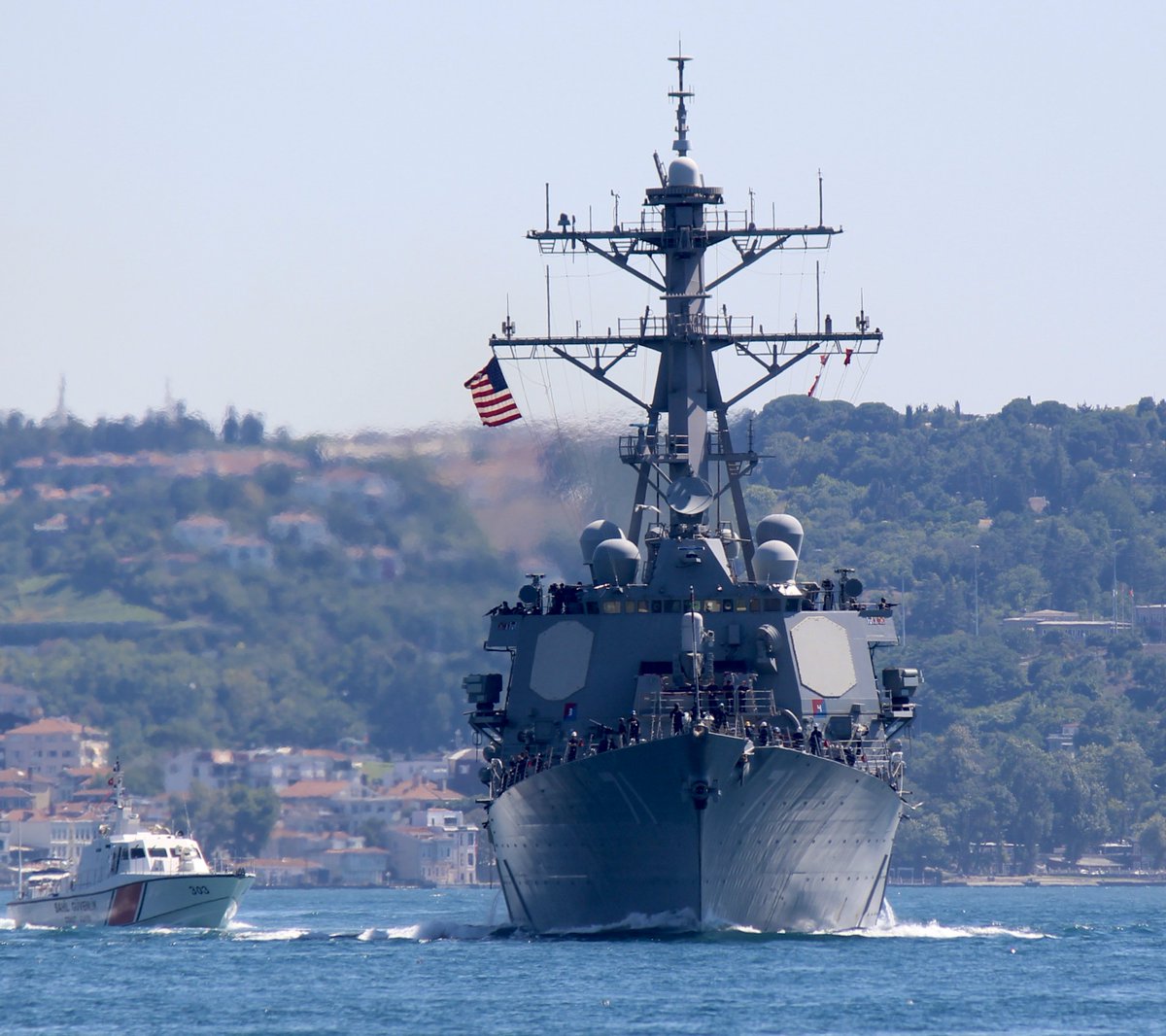




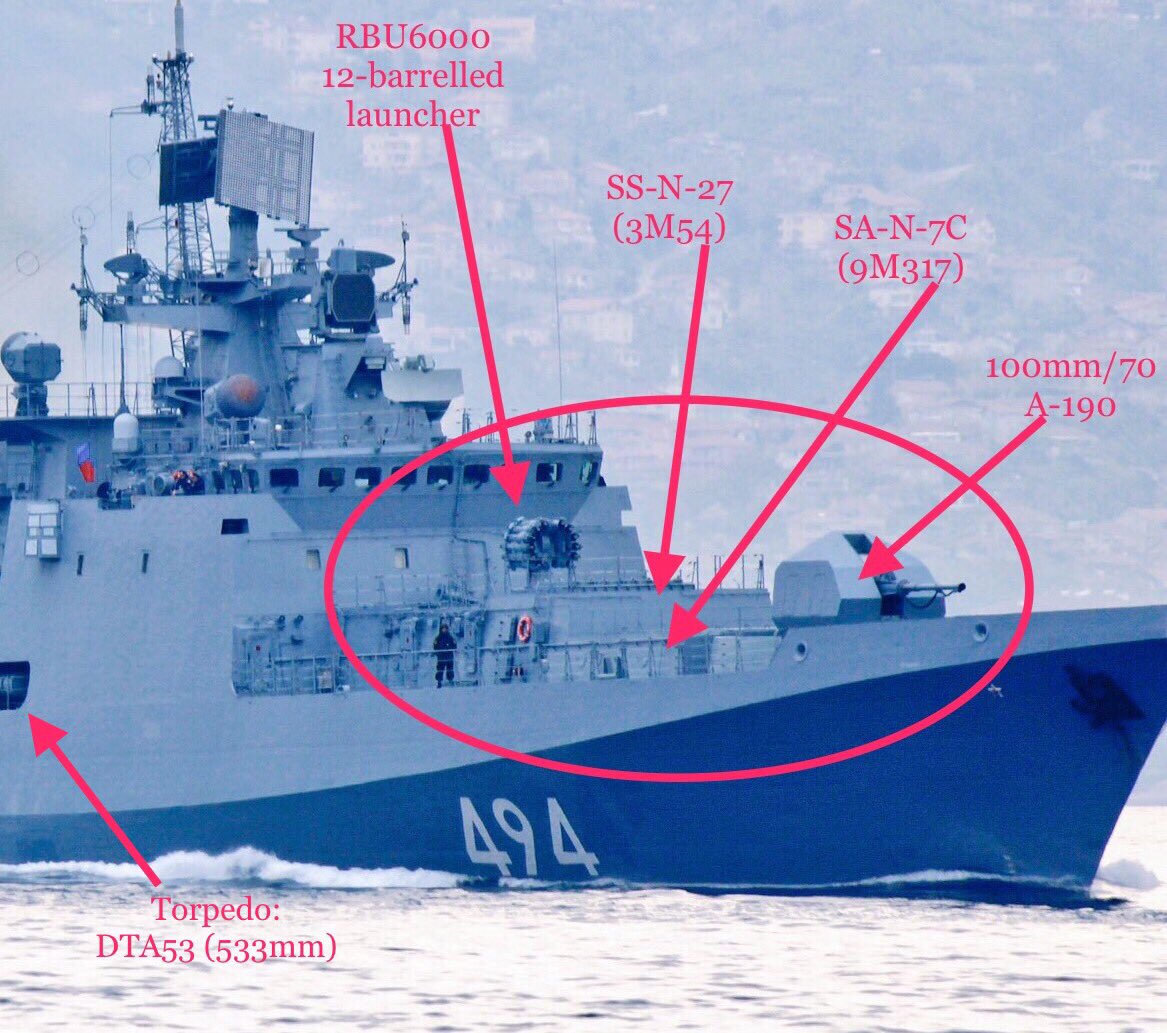
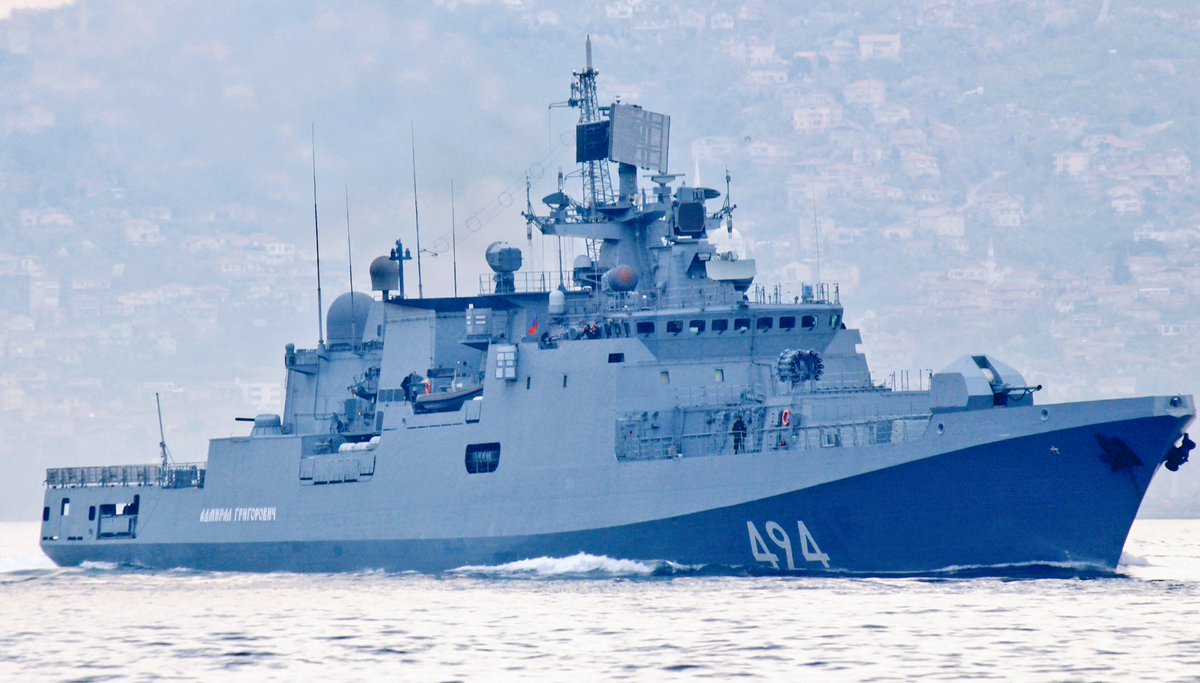
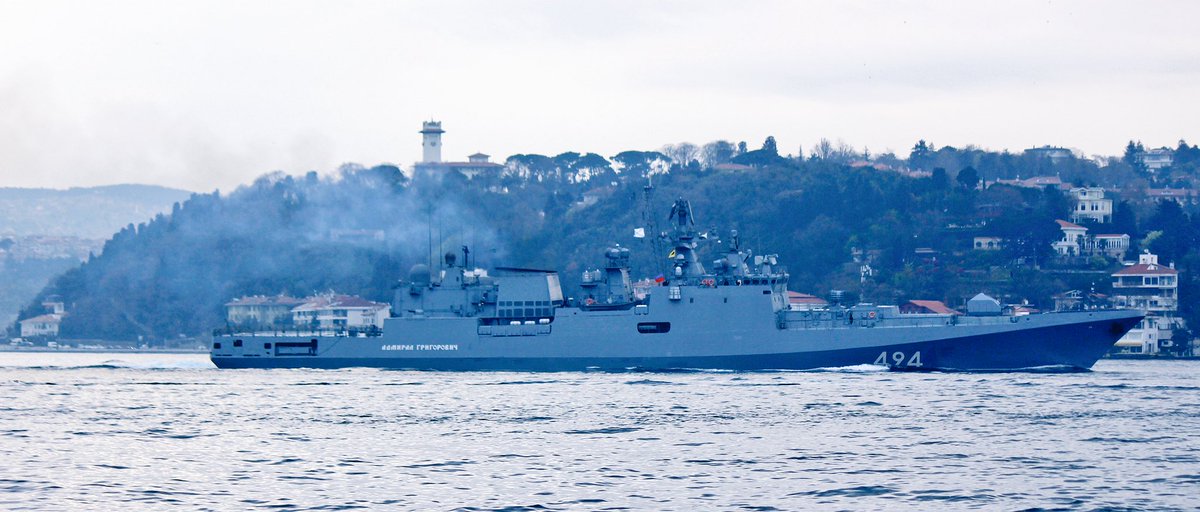
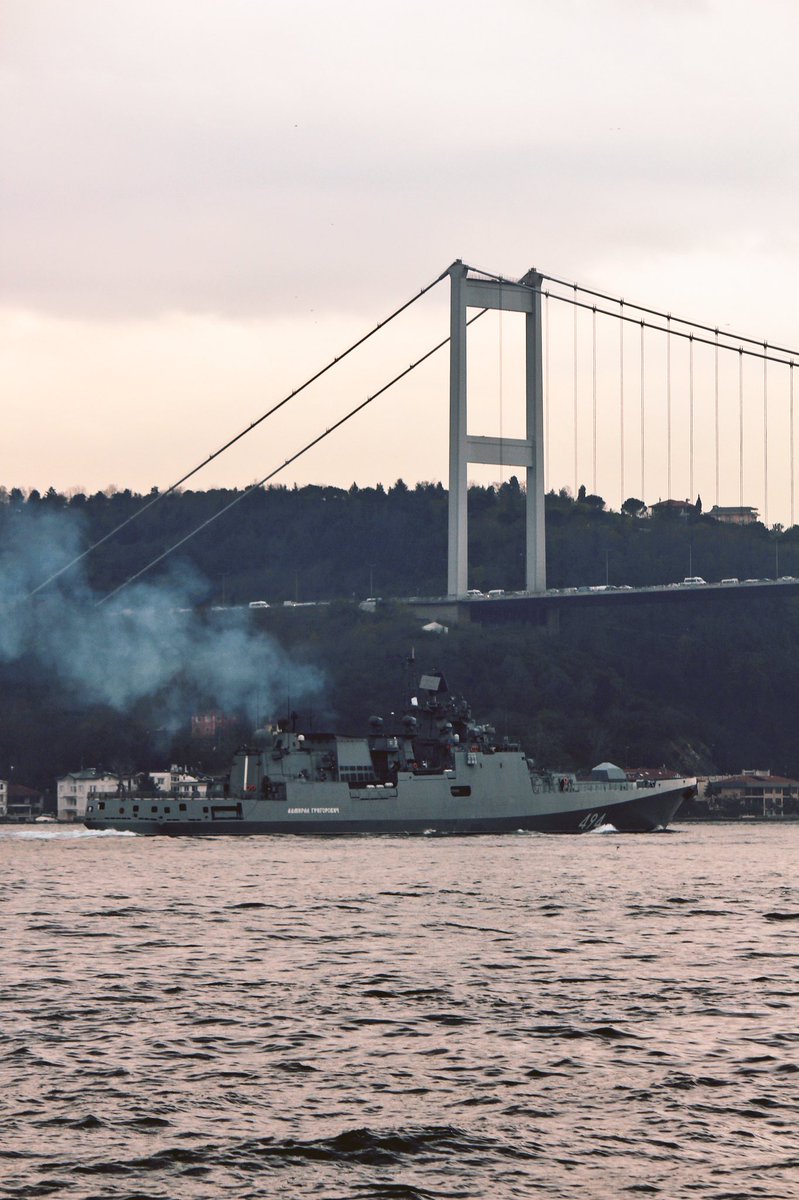
















2 comments:
Closely Watched Trains (Jiri Menzel, 1966): Opening Scene
another bit of the above
Fred Neil: Dolphins [1967] HQ
Post a Comment